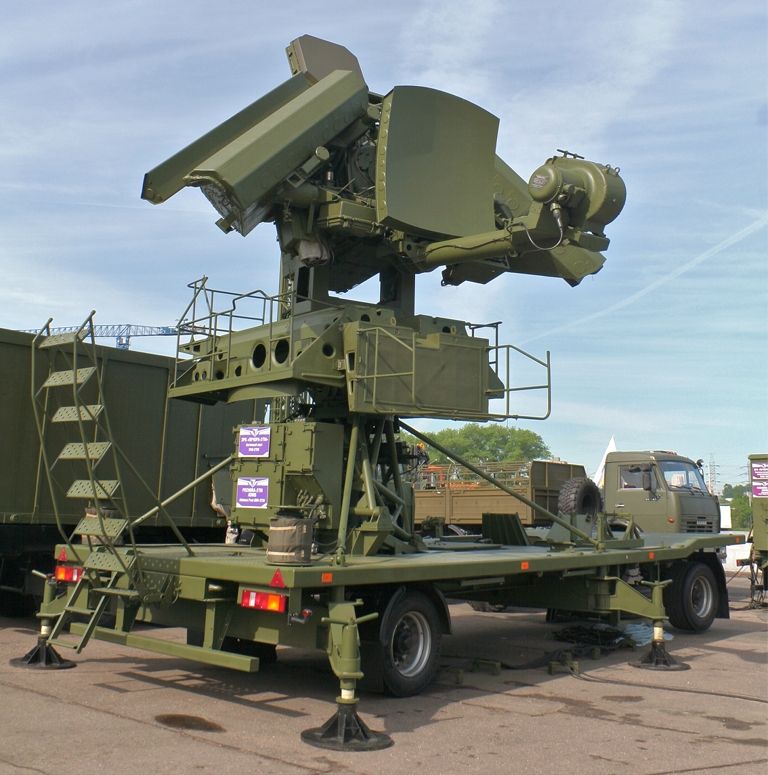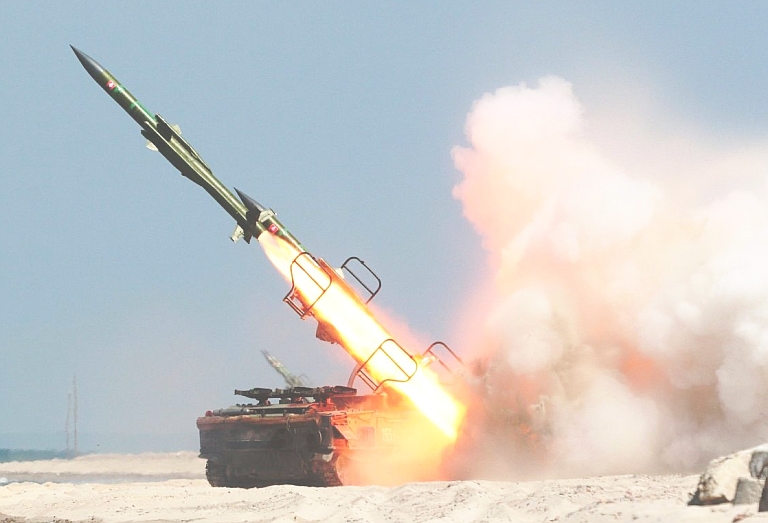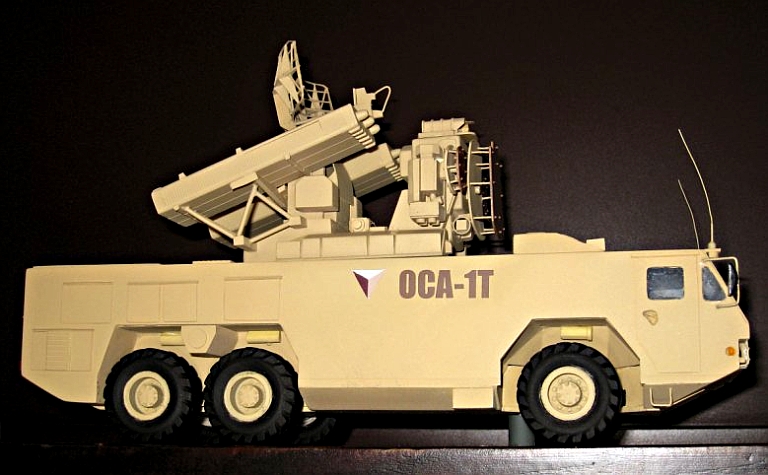|
||||||||||||||||||||||
![Home - Air Power Australia Website [Click for more ...]](APA/APA-Title-Main.png) |
||||||||||||||||||||||
![Sukhoi PAK-FA and Flanker Index Page [Click for more ...]](APA/flanker.png) |
![F-35 Joint Strike Fighter Index Page [Click for more ...]](APA/jsf.png) |
![Weapons Technology Index Page [Click for more ...]](APA/weps.png) |
![News and Media Related Material Index Page [Click for more ...]](APA/media.png) |
|||||||||||||||||||
![Surface to Air Missile Systems / Integrated Air Defence Systems Index Page [Click for more ...]](APA/sams-iads.png) |
![Ballistic Missiles and Missile Defence Page [Click for more ...]](APA/msls-bmd.png) |
![Air Power and National Military Strategy Index Page [Click for more ...]](APA/strategy.png) |
![Military Aviation Historical Topics Index Page [Click for more ...]](APA/history.png)
|
![Intelligence, Surveillance and Reconnaissance and Network Centric Warfare Index Page [Click for more ...]](APA/isr-ncw.png) |
![Information Warfare / Operations and Electronic Warfare Index Page [Click for more ...]](APA/iw.png) |
![Systems and Basic Technology Index Page [Click for more ...]](APA/technology.png) |
![Related Links Index Page [Click for more ...]](APA/links.png) |
|||||||||||||||
![Homepage of Australia's First Online Journal Covering Air Power Issues (ISSN 1832-2433) [Click for more ...]](APA/apa-analyses.png) |
||||||||||||||||||||||
| Last Updated: Mon Jan 27 11:18:09 UTC 2014 | ||||||||||||||||||||||
|
||||||||||||||||||||||
Legacy Air Defence System UpgradesTechnical Report APA-TR-2009-0601 |
||||||||||||||||||||||||||||||||||||||||||||||||||||||||||||||||||||||||||||||||||||||||||||||||||||||||||||||||||||||||||||||||||||||||
| by
Dr
Carlo
Kopp, AFAIAA, SMIEEE, PEng June, 2009 Updated July, 2009 Updated May, August 2011 Updated April, 2012 Text © 2009-2012 Carlo Kopp |
||||||||||||||||||||||||||||||||||||||||||||||||||||||||||||||||||||||||||||||||||||||||||||||||||||||||||||||||||||||||||||||||||||||||
 |
||||||||||||||||||||||||||||||||||||||||||||||||||||||||||||||||||||||||||||||||||||||||||||||||||||||||||||||||||||||||||||||||||||||||
|
||||||||||||||||||||||||||||||||||||||||||||||||||||||||||||||||||||||||||||||||||||||||||||||||||||||||||||||||||||||||||||||||||||||||
| |
||||||||||||||||||||||||||||||||||||||||||||||||||||||||||||||||||||||||||||||||||||||||||||||||||||||||||||||||||||||||||||||||||||||||
Introduction
|
||||||||||||||||||||||||||||||||||||||||||||||||||||||||||||||||||||||||||||||||||||||||||||||||||||||||||||||||||||||||||||||||||||||||
| System |
Class
2 |
Class
3 |
Class
4 |
| SA-2
Guideline |
TBD |
HQ-2B/J
/
SJ-202 |
Possibly
H-200
integration |
| Polish
Newa-SC Almaz-Antey Pechora 2A Tetraedr Pechora 2T/2TM Defense Systems Pechora 2/2M |
Polish
Newa-SC Tetraedr Pechora 2TM Defense Systems Pechora 2/2M |
TBD |
|
| SA-5
Gammon |
Tetraedr
S-200 |
N/A |
Almaz-Antey
S-300PMU2 Almaz-Antey S-400 |
| SA-6
Gainful |
Czech
RETIA |
N/A |
TBD |
| SA-8
Gecko |
Kupol
Osa
AKM Tetraedr Osa-1T |
N/A | TBD |
| SA-11
Gadfly |
Tetraedr
Buk
MB Agat 9B-1103M-350 |
N/A | TBD |
Hybridisation will present a major issue in coming years, exacerbating challenges in defeating digital variants of Soviet era systems. A sophisticated long range phased array engagement radar such as the 30N6E2 Tomb Stone or 92N2E Grave Stone when mated with a legacy missile system such as the SA-2, SA-3, SA-5 or SA-6 completely transforms the capabilities of the legacy system. While the legacy missile round might be a stone axe by contemporary standards, it becomes a stone axe hurled with high precision by a highly survivable and jam resistant state-of-the-art sensor system.
In a sense, this development emulates the long established Western practice of mating smart digital seekers to legacy unguided munitions to transform their capabilities. The availability of modern active radar seekers for legacy SAM rounds in the 2K12 Kub/Kvadrat / SA-6 Gainful system in fact directly follows the Western technology insertion pattern, with similar transformational impact.
Upgrades to legacy air defence weapons are changing the air power game, as the Russians learned in Georgia during their 2008 adventure. A good number of Russian aircraft were shot down by Georgian SAM batteries, as their electronic countermeasures proved ineffective. What the Russians confronted in Georgia were legacy systems covertly upgraded with new hardware by Ukrainian defence contractors, active players in the global upgrade market.
The Russian experience in Georgia is a lesson which remains to be understood by Western defence bureaucracies.
Technical Note #2 SAM Seeker Retrofits
Most of the known upgrades to legacy SAM systems involve replacement of analogue engagement radar, and often supporting acquisition radar, modules and components with modern technology COTS based digital replacements. Often thermionic technology transmitters and receivers are replaced with modern solid state components. This in itself typically provides significant gains in jam resistance, clutter rejection and detection range [sensitivity] for low signature targets. Moreover, improved clutter rejection typically improves tracking capability against low altitude targets, a particular weakness of most Cold War era Soviet designs. Improved control laws in command link guided weapons have also produced significant range envelope improvements.
To date seeker retrofits have been less common. This is for several reasons. The first and foremost is that most upgrades to date have been performed on SA-2 and SA-3 systems which are command link systems without terminal homing seekers, and the desire was to permit reuse of existing warstocks of missile rounds. The second reason has been cost, as a digital upgrade to an engagement radar incurs costs only against a small number of such devices, compared to hundreds or thousands of missile rounds in warstock. The additional operational flexibility and lethality gained has evidently been considered less important.
The Iraqi program to retrofit the R-60 Aphid infrared seeker to the 3M9 / SA-6 missile resulted from a very different imperative, which was lethality in an intensive countermeasures environment. The 3M9/9M9 missile has also been the target of Agat's seeker upgrade effort, with similar objectives to the Iraqi effort.
The 3M9/9M9 is an attractive candidate for retrofits, not only due to its wide installed base, but also because integration of a replacement for the existing 1SB4 semi-active homing seeker is a straightforward if not minimal effort. An adaptor must be produced to provide signal outputs which emulate those produced by the 1SB4, and inputs to the 1SB4 from the autopilot, and a power supply adaptor is required to condition the power supply intended for the 1SB4 to the new seeker. Only if the new seeker drew significantly more power would it be necessary to replace the existing missile internal power supply.
A more sophisticated replacement seeker design would contain an embedded modern FOG or RLG inertial module, possibly a GPS/Glonass receiver, a modern digital command link modem, but also replace the legacy autopilot and its embedded control laws.
Replacement of the legacy 5G22/5G23/5G24 CW semi-active homing radar seeker in the 5V21 and 5V28 / SA-5 Gammon missiles would follow a similar pattern and is also a low risk and low development cost effort.
The low cost and technological risk involved in performing a seeker block upgrade of this kind raises other issues, as it is conceivable that it could be performed covertly and present a "strategic surprise" scenario in combat.
Retrofits to legacy command link guided missiles are more challenging, insofar as both the S-75 / SA-2 and S-125 / SA-3 missile rounds would require more radical surgery, with the complete replacement of the radio proximity fuse, command link receiver, and autopilot. Whether the replacement seeker is infrared or active radar, the missile nosecone would need to be replaced and nose mounted hardware repackaged. Such an upgrade would however not only improve the lethality of the weapon, but also significantly extend its viable service life, with periodic relifing of solid propellants and pyrotechnics. Given the declining global inventory of the S-75 / SA-2, the S-125 / SA-3 is a more viable candidate.
In summary the technical risk and effort involved in seeker retrofits varies from low to modest, and given the significant lethality gains which result, we should not be surprised to encounter them in future conflicts.
Technical Note #3 Agat Active Radar Seekers for SAM Upgrades

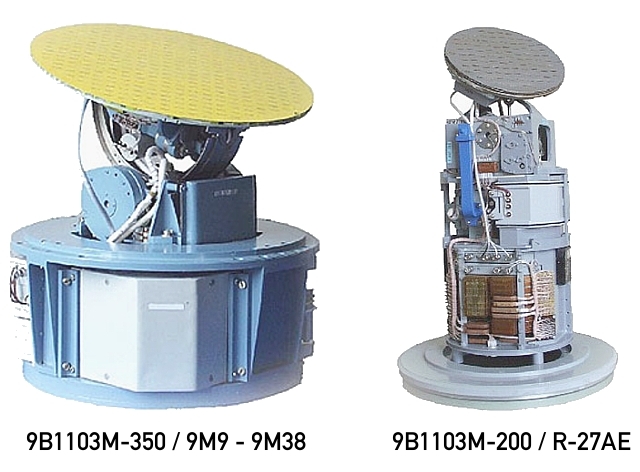 |
The 9B-1348 family of
active radar terminal / inertial/datalink midcourse guided seekers
developed for the RVV-AE / R-77 / AA-12 Adder AAM has produced
important spinoffs. These are the 9B-1103M series of seekers, offered
as new build or retrofit active
radar seekers for AAMs or SAMs. The Agat 9B-1103M-200 is intended for
the R-27A/AE / AA-10 Alamo, and is directly derived from
the R-77 9B-1348E seeker. The latest subtype of this seeker is claimed
by Agat to use the Texas Instruments TMS-320 digital signal processing
chip, widely used in Western radar equipment.
The 9B-1103M-350 is a variant which is specifically designed as a replacement retrofit seeker for existing new build or legacy semi-active homing SAM seekers, with the 3M9/9M9 (SA-6) and 9M38 (SA-11/17) cited as specific targets for such upgrades. Active radar homing seekers offer numerous tactical advantages absent in 'conventional' semi-active seekers, where the engagement radar is committed to illuminating the target until missile impact. With an 'AMRAAM-like' seeker the missile can be launched in several modes:
The latter two modes are
especially of interest since the engagement radar may be operating in a
track while scan mode and the victim may not know it is under attack
unless it can detect the missile uplink transmissions, in the latter of
the two modes. The latter two modes are also compatible with third
party tracking where the engagement radar is not emitting search or
track signals, launching and guiding the missiles against an aimpoint
provided by another sensor such as an Emitter Locating System or other
radar.
Other than flexibility in guidance modes and reduced warning time, active radar seekers also present opportunities to engage multiple and separated targets concurrently within a sector covered by the engagement radar. Since Agat first displayed the 9M1103M-350, the company has developed an enhanced 240 mm diameter seeker for the R-37 / AA-13 Arrow AAM, which is capable of acquiring a 5 m2 target at 70 km range. The range of derivative seekers produced by Agat present upgrade opportunities for a number of SAM types other than the SA-6/11/17 initially targeted by the company's marketing effort. There are respectable inventories of the legacy SA-3, SA-5, SA-8 and SA-10 in many nations, which if retrofitted with modern active radar seekers become significantly more lethal and survivable.  |
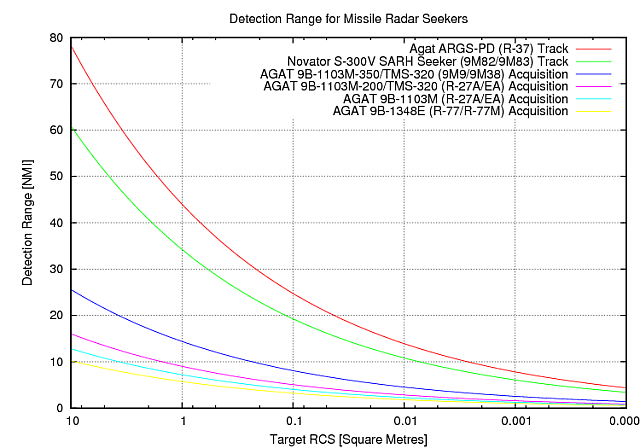 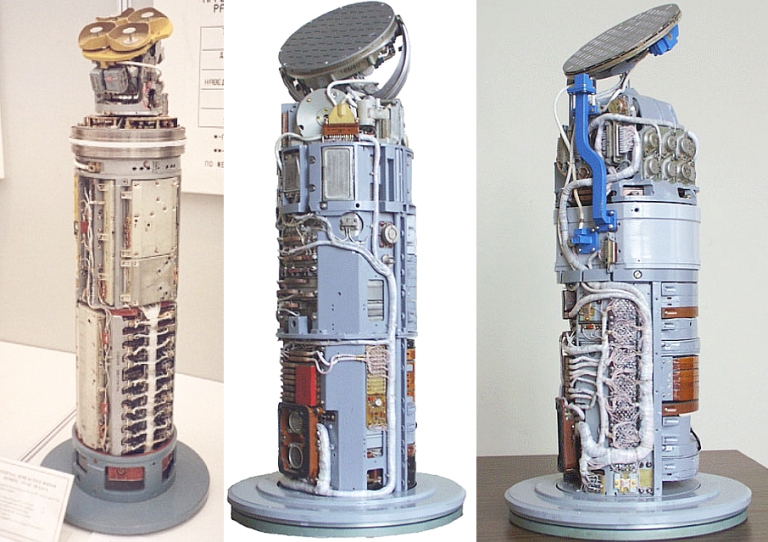 Agat AAM seekers. Left to right: 9B-1101K
dual plane monopulse semi-active homing seeker used in R-27R1/ER1, 9B-1348E active
radar homing seeker used in R-77 variants, and 9B-1103M active radar homing seeker for
R-27EA (Agat).
|
Technical Note #4 Anti-Radiation Seekers for SAM Upgrades
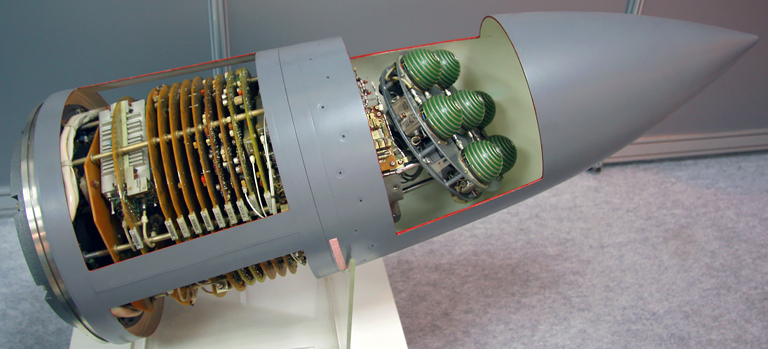
There are no open source reports of dedicated anti-radiation seekers being installed in recent Russian SAM designs. A narrowband passive anti-radiation capability is likely in more recent semi-active and TVM capable seekers, as this capability exists in supersonic anti-shipping missile active radar seekers of similar size.
There are no fundamental technical obstacles to the retrofit of a wideband anti-radiation seeker to larger Russian SAM airframes, such as the 48N6, 9M82, 9M83 or legacy 5V28. Existing seekers such as the Avtomatika L-111E/112E/113E series used in subtypes of the Kh-31 / AS-17 Krypton anti-radiation missile are geometrically and volumetrically compatible with these SAM airframes. Guidance adaptations would not be particularly challenging where the missile employs midcourse command link / inertial guidance, the principal aim being to fly the missile into a viable acquisition basket for the seeker, and cue the seeker to acquire the intended emitter. Modern anti-radiation missile seekers are usually capable of autonomous target acquisition, or re-acquisition should an emitter go silent transiently.
The technology is certainly available to inexpensively equip any number of recent Russian SAM airframes with anti-radiation seekers. Passive targeting capability via emitter locating systems such as the 85V6 Vega / Orion or Kvant 1L222 Avtobaza presents no difficulty, both designs have been integrated with the S-400 / SA-21 fire control system. The CONOPS for such a system would involved passive angle tracking and ranging on an emitter, with the SAM round flown out under command link control to a geometrically optimal position, upon which the anti-radiation seeker would acquire the target and terminal homing would be performed. Existing control laws for terminal homing in HOJ modes would be viable.
Until terminal homing is initiated, a defending aircraft will have no easy means of determining whether an inbound SAM is fitted with an anti-radiation seeker. This will complicate defensive countermeasures scheduling and defensive tactics. A salvo of two SAMs, one with an anti-radiation seeker, and one with an active or semi-active homing seeker, will present similar difficulties to those seen with the use of mixed seeker types in Beyond Visual Range (BVR) AAM attacks.
Legacy System Upgrades
HQ-2A/B
/ CSA-1 / S-75 / SA-2
Guideline SAM System Upgrades
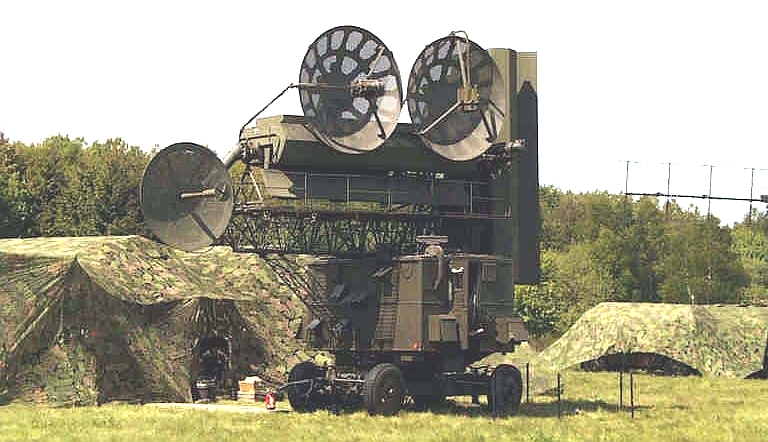
The ubiquitous S-75 / SA-2 Guideline can claim the distinction of being the most widely exported area defence SAM system of all times. While now regarded to be obsolescent, it still remains widely used, with China still operating ~60 batteries. Each six launcher battery uses a single SNR-75 Fan Song / Gin Sling engagement radar. The missile round uses a liquid propellant terminal stage with a solid propellant first stage booster.
The PLA reverse engineered the Soviet V-75/S-75 Dvina / SA-2 Guideline SAM system during the 1960s, including the SNR-75 Fan Song radar, the SM-90 launcher and the PR-11AM transporter/transloader. Since then the PLA developed a significantly improved HQ-2B variant. China is reported to still be supplying spare parts for a number of operators, and is known to have supplied the system to Iran.
There are at this time a number of known upgrades on offer, and two known fully mobile TEL designs for the S-75, one developed by the Chinese and one by the Cubans.
Almaz-Antey S-75-2/S-75M3 Volga-2 Upgrade
Almaz-Antey launched in 2001 the Volga-2/2A package of technology insertion upgrades for the legacy S-75/75M designs, using digital components previously used in the S-300PMU1/2 / SA-20 Gargoyle.
Russian sources claim the following enhancements to the design via the use of new digital components: improved countermeasures resistance for the missile uplink and radar; automatic tracking modes for targets, extended kinematic range via better control law design, and cope with adverse ECM environments.
Specific claims include:
- The ability to acquire and track targets, and guide missiles, when subjected to noise jamming intensities of 2000 W/MHz produced by a standoff jammer at 100 km range.
- Increased clutter and chaff rejection performance.
- Extended missile kinematic range to 60 km.
- Maintain target tracks in the event of temporary signal loss.
- Automatically acquire targets.
- Reduced automatic target tracking error to 0.02 mrad.
- Estimate target altitude relative to horizon to improve Pk against low flying targets.
- Reduced crew complement.
- Reduced power consumption by 40%.
- Improved MTBF.
| Характеристика Characteristic |
Волга Volga |
Волга-2 Volga-2 |
| Зоны поражения Engagement Envelope |
||
| Диапазон
высот,км Altitude Range [km] |
0.1-30 | 0.1-30 |
| Максимальная
дальность
на
высоте
0.5км Maximum range at altitude of 0.5 km |
24 км | 27 км |
| Максимальная
дальность
на
высоте
5-25км Maximum range at altitude of 5 to 25 km |
40-55 км | 45-60 км |
| Максимальная
дальность
на
высоте
30км Maximum range at altitude of 30 km |
50 км | 55 км |
| Максимальный
параметр
на
высоте
0.5км Maximum performance at altitude of 0.5 km |
22 км | 26 км |
| Максимальный
параметр
на
высоте
5-25км Maximum performance at altitude of 5 to 25 km |
38-50 км | 40-50 км |
| Максимальный
параметр
на
высоте
30км Maximum performance at altitude of 30 km |
34км | 45км |
| Вероятность
поражения цели одной ракетой Single Round Pk |
||
| на
дальности
до
50км at ranges of up to 50 km |
0.4-0.97 | 0.56-0.98 |
| на
дальности
50-60км at ranges of 50 to 60 km |
- | 0.41-0.98 |
| Характеристики
помехозащищенности Countermeasures Resistance |
||
| Помеха, уводящая по углу: |
|
|
| угловые
ошибки
сопровождения(с
ГШВ) angular tracking error (with -) |
2.5'-4' | 1.5'-2' |
| угловые
ошибки
сопровождения(без
ГШВ) angular tracking error (without -) |
6.0'-12' | 1.0'-2' |
| Селекция
движущихся
целей Moving Target Indication |
|
|
| угловые
ошибки
сопровождения
целей
на фоне отражений от местных предметов и в
пассивных помехах angular tracking error in th presence of clutter and chaff |
3'-5' | 3'-4' |
| угловые
ошибки
сопровождения
целей
в "МВ" angular tracking error |
до 15' | 3'-4' |
| пролонгация
сопровождения
целей
на
фоне отражений от местных предметов tracking of targets against clutter |
нет no |
есть yes |
| работа
в
АШП
по
фону ДНА (Rn=100км), Вт/МГц Noise jamming resistance |
100 | 2000 |
| Ответно-импульсные
помехи
(вобуляция
периода
повторения по псевдослучайному закону) ECCM against deception repeaters |
нет no |
есть yes |
| Время
автозахвата
цели
на
АС,с Time to acquire target [sec] |
8 | 2.5-3 |
| Прибор пуска Launch Modes |
||
| режим
работы operating regime |
полуавтомат semiautomatic |
автомат automatic |
| время
выработки
данных,с data output interval [sec] |
7 | 2 |
| точность
оценки
координат
точки
встречи,км location error [km] |
2.0-5.0 | 0.5 |
| индикация
гарантированной
зоны
поражения Launch Acceptable Region indication |
нет no |
есть yes |
| индикация
формуляра
цели
(азимут,
угол места, дальность,высота, скорость,
параметр,текущий промах) target parametric display (azimuth, elevation, range, altitude, velocity, performance, -) |
нет | есть |
| Работа
ТВК
А3
и
АС цели (2 канала) |
нет no |
есть yes |
| Текущий функциональный контроль | нет | есть |
| Система
внутристанционных
измерений
и
боевого документирования на базе РС mission recorder |
нет no |
есть yes |
| Table:
Almaz-Antey
brochure S-75M3 air
defense missile system cited at http://www.new-factoria.ru/missile/wobb/c75m3/c75m3.shtml |
||
Tetraedr S-75-2T Volga-2T Upgrade
In 2003 Tetraedr in Belarus announced the development of the S-75-2T Volga-2T upgrade package for the S-75 / SA-2 system. This upgrade draws upon the technology base developed for upgrades of the S-125 / SA-3 system. It is not currently detailed on the Tetraedr website.
The upgrade package on offer is to provide a comprehensive technology replacement of all key components in the SNR-75 Fan Song engagement radar. Cited improvements include a reduction of the system down to two trailers, digital data and signal processing, new missile control laws to extend range, and a mobility upgrade with a 20 minute stow/deploy time.
Tetraedr also offer overhauls and zero timing of 20D and 5Ya23 missile rounds for the system.
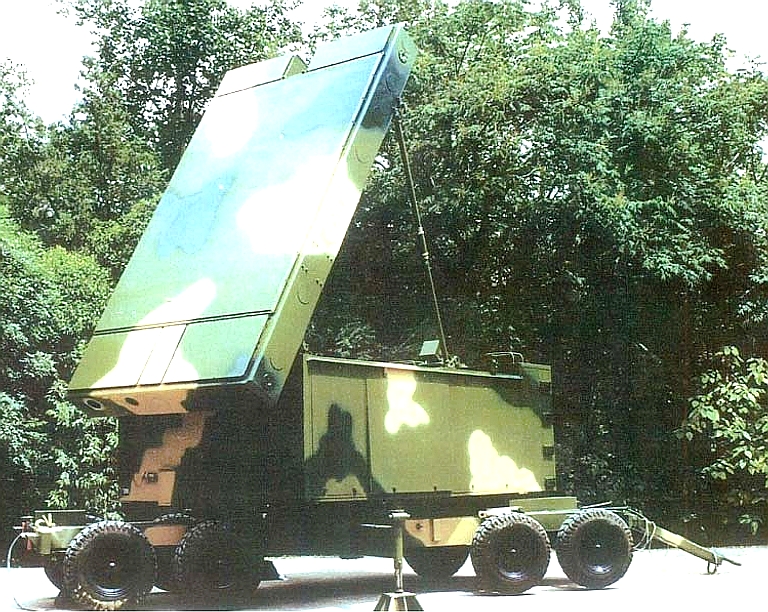
The H-200 phased array engagement radar was developed to support the new HQ-12/KS-1A SAM system. Hybridisation of the H-200 radar and the existing HQ-2B/J missile system would transform the capabilities of the HQ-2, and open up a large export market for the H-200 and other Chinese radars (Chinese internet images).
Some evidence has emerged, albeit inconclusive as it is not supported by public disclosures, that the PLA may be hybridising its new HQ-12/KS-1A SAM system with the legacy HQ-2B/J / CSA-2 Guideline SAM system. The PLA remains the world's largest single user of the SA-2, with domestically re-engineered missile rounds and SJ-202 Gin Sling series engagement radars. The PLA has also deployed a fully mobile HQ-2 TEL on a tracked chassis. In practical terms the PLA has a large material and intellectual investment in the SA-2 family of weapons. Hybridising the HQ-2 and HQ-12 would therefore make sense economically as it would allow exploitation of the HQ-2 inventory and warstock until the type is wholly replaced by newer technology weapons.
As the HQ-2 is a simple command link guided missile, hybridisation with a newer missile system involves only the installation of software and hardware in the engagement radar which cues and commands the HQ-2B TELs or static SM-90 launchers, permits tracking of the missile, and which generates uplink commands to the missile during flight. With the Fan Song / Gin Sling operating at X-band (G/E/F depending on subtype), and given the robust antenna bandwidth available with a transmissive space feed PESA arrangement as used in the H-200 engagement radar for the HQ-12/KS-1A, there would be no fundamental technological obstacles to adapting the H-200 to provide a midcourse tracking and command uplink guidance capability for the HQ-2 / SA-2 missile round. It is worth observing that Chinese sources claim the predecessor to the KS-1A, the KS-1, employed the same Gin Sling engagement radar as the HQ-2B/J. If this is true, then the degree of commonality in missile electronics and waveforms between the KS-1A and HQ-2B/J could be very high, facilitating hybridisation.
A HQ-2B/J missile battery equipped with a modern frequency hopping H-200 engagement radar and a JY-11/JY-11B, YLC-18, JYL-1 acquisition radar becomes an entirely different proposition to the legacy article, in terms of its engagement envelope, tactical mobility, and its resistance to jamming.
Given the large number of existing users of the S-75 / SA-2 and HQ-2 / CSA-1 on the global stage, China could well have a major commercial motive to develop a hybrid domestically, since it would open a significant export market for the H-200 radar, and its competitor, the SJ-231, as well as replacement JY-11B, YLC-18 and JYL-1 acquisition radars.
PLA HQ-2B WXZ204 Tracked
TEL Upgrade
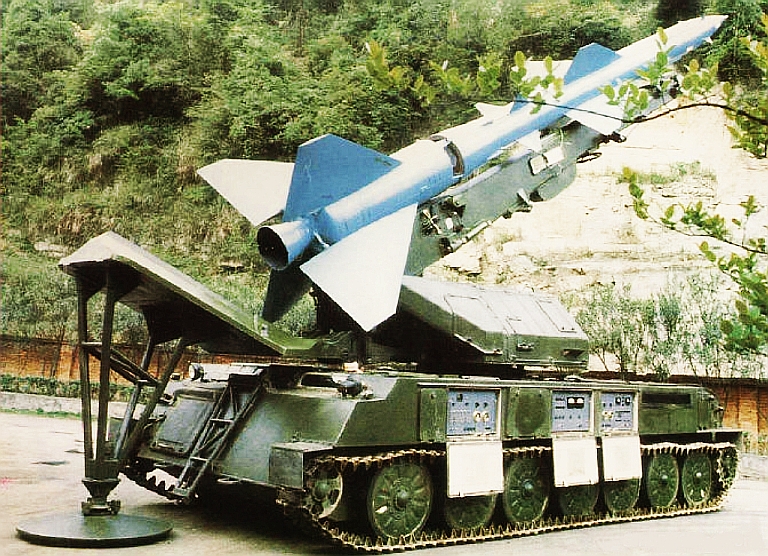
A tracked TEL, the WXZ204, was developed to replace the cloned SM-90. The PLA remains the single largest user of the S-75 globally, even though the weapon is being progressively replaced. The tracked TEL chassis appears to be a unique design, but evidently using components from the Type 63 light amphibious tank, itself a derivative of the Soviet PT-76 [Click for more ...].
Cuban
SM-90/T-55 Tracked TEL Upgrade
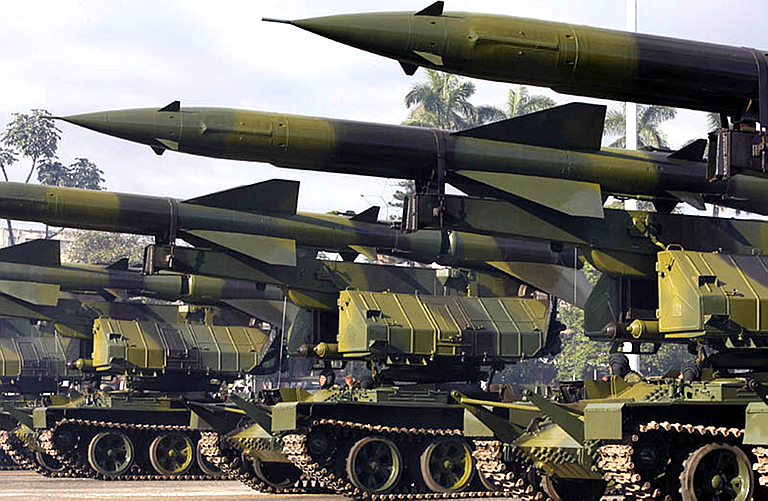
Cuba has developed and deployed an indigenous TEL based on the Soviet SM-90 launcher and the obsolete T-55 tank chassis. The total number of conversions is unknown, but multiple TELs were publicly displayed during the 2006 Havana parade, and TELs have been displayed in two very different camouflage patterns suggesting multiple units equipped with the design. This design shares features with the Cuban SA-3 TEL design, and differs in many respects from the PLA HQ-2 TEL.
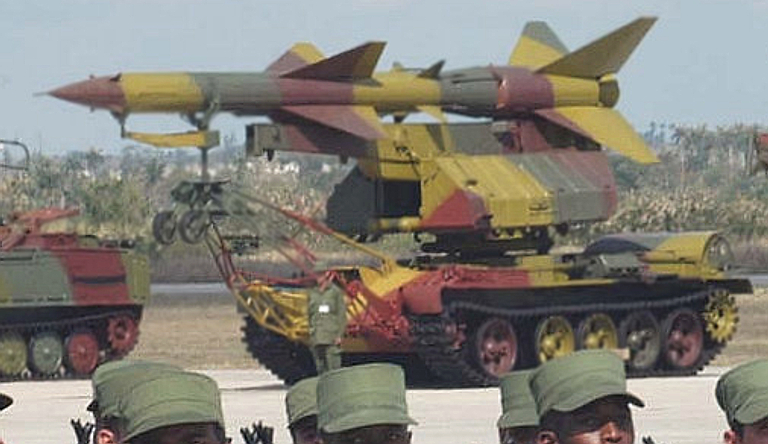
This image shows the wheeled support frame for the nose of the missile round, in stowed position for transport. This frame is removed from the TELs used for the street parade. This is a fundamentally different design approach to the WXZ204 HQ-2B TEL, where the launch rail was extended.
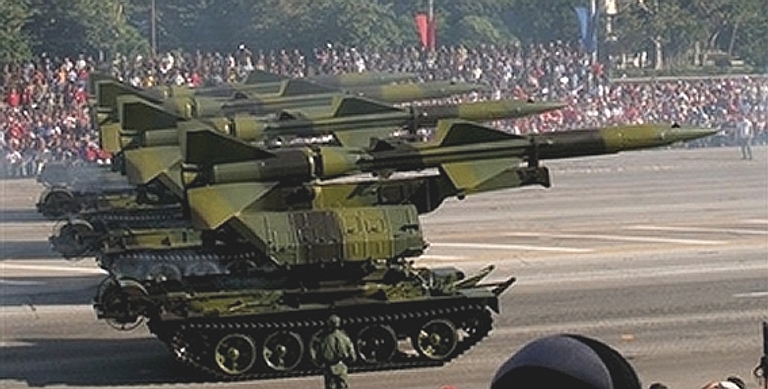
S-125 Neva/Pechora / SA-3 Goa SAM System Upgrades
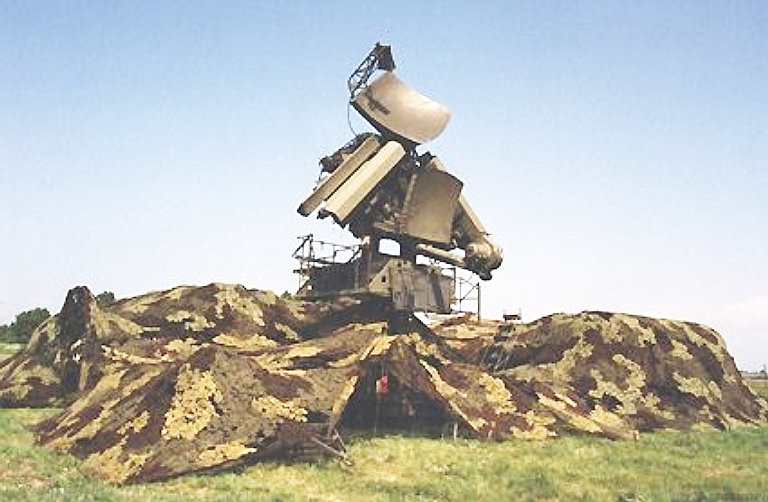
Following the end of the Cold War, a number of upgrade packages have emerged for the S-125 / SA-3 Goa, mostly involving digital upgrades to the radar and guidance package, but some involving rehosting on vehicles to provide a mobile rather than semi-mobile capability. The S-125 / SA-3 Goa has been a more attractive target for upgrades compared to the S-75 / SA-2 Guideline, as the missile is newer by design, and less cumbersome to support as both stages uses solid propellant motors.
Tetraedr S-125T/2T Pechora 2T/2TM Upgrades
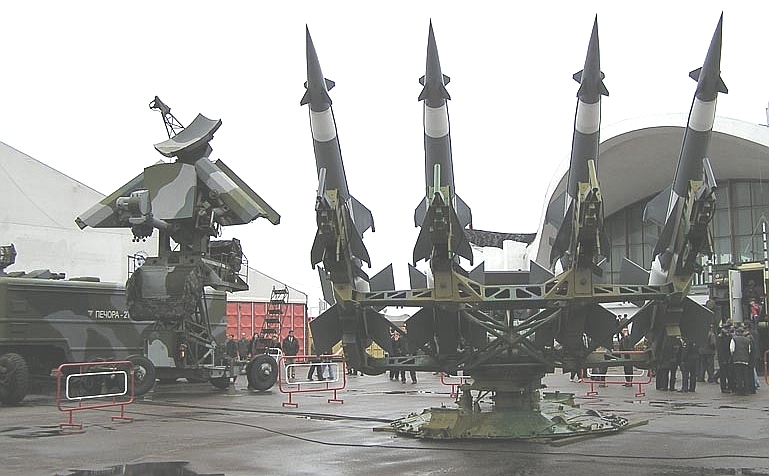
Tetraedr have developed two upgrade packages, the Pechora 2T and further enhanced Pechora 2TM. These upgrades involve redesign of key radar components, a new upper antenna aperture, and revised autopilot software. For the Pechora 2T the cited improvement in jam resistance is 2700 W/MHz (AWGN) vs 24 W/MHz for the legacy design, suggesting the use of a frequency hopping design with a better than 100:1 spreading ratio. The Pechora 2TM uses an new trailer for the UNV-2TM Low Blow. A CPTЗ-125 seduction decoy is packaged into the upgrade. Deployment time is 20 minutes.
Tetraedr are offering a heavily upgraded UNV-2TM Low Blow on a new design towed chassis as part of the Pechora 2TM upgrade (© 2011 Michael Jerdev).
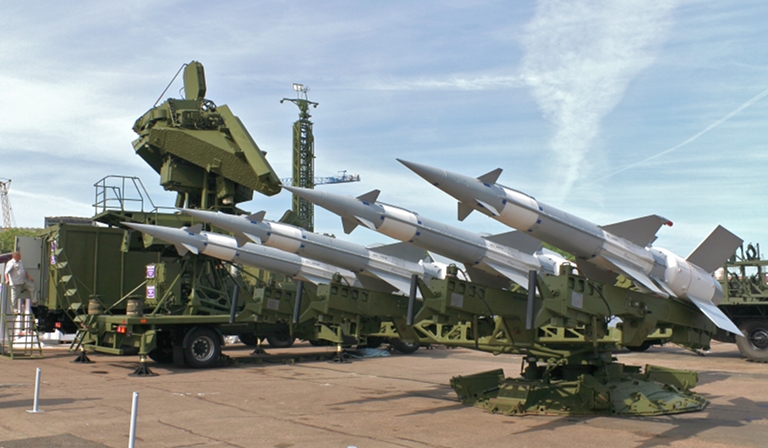
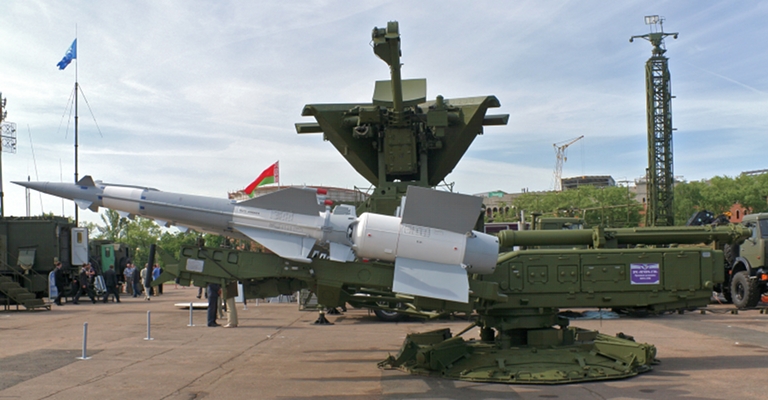
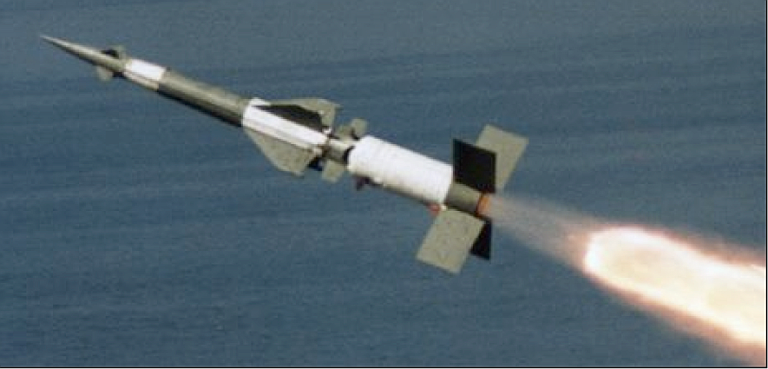
5V27 Goa missile launch
(Tetraedr).
Tetraedr
Data
Pechora
2T
|
Characteristics |
"Pechora" ADMS |
"Pechora-2T" ADMS |
|
1. Channels capacity, target |
1 |
2 |
|
2. Channels capacity, SAM |
2 |
2 |
|
3. Maximum target detection range, km |
80 |
100 |
|
4. Maximum speed of targets engaged, head-on/receding, m/s |
700 / 300 |
900 / 300 |
|
5. Minimal altitude of target engaged, km |
0.02 |
0.02 |
|
6. Maximum altitude of target engaged, km |
18 |
25 |
|
7. Range to near boundary of engagement zone, km |
3.5 |
3.5 |
|
8. Range to remote boundary of engagement zone, km |
17 |
26.5 |
|
9. Maximum slant range of engagement zone, km |
24.8 |
35.4 |
|
10. Maximum course parameter of the target engaged, km |
16.5 |
25 |
|
11. SAM guidance methods |
HL , TP |
KDC , MTP |
|
12. Jamming protection of SAM System: |
24 |
2700 |
|
13. Kill probability of target by one SAM: |
|
|
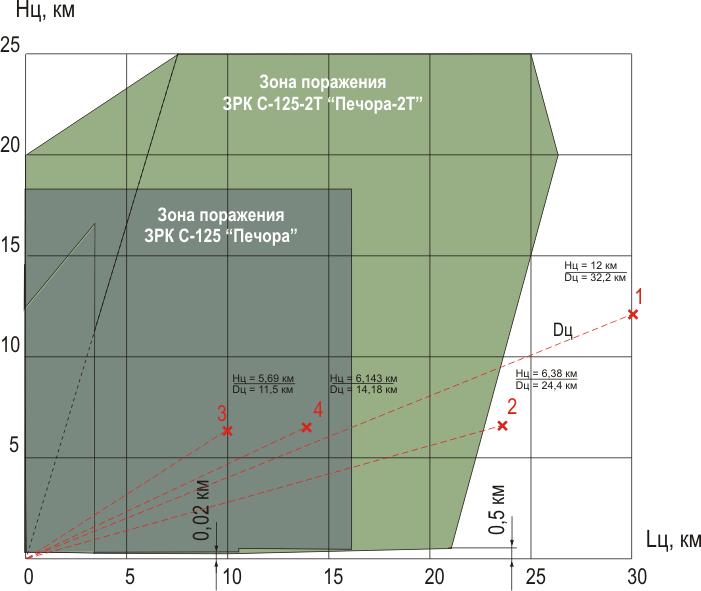
Defence
Systems
S-125-2M/2K Pechora 2M/2K Upgrade
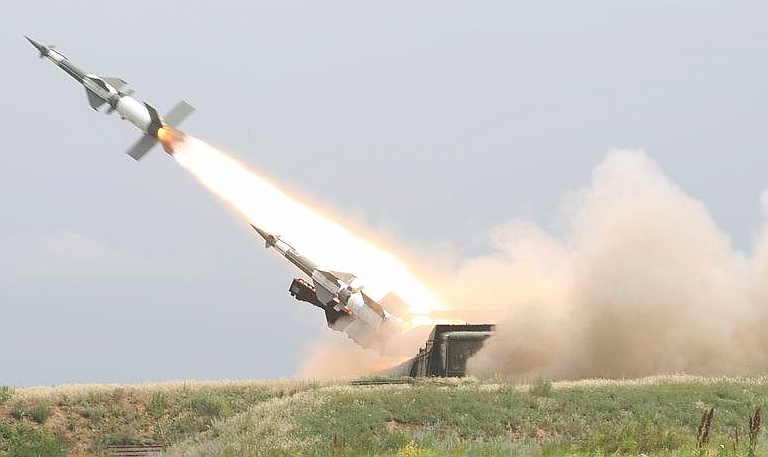
Rosoboronexport Description (Cite):
The modernisation programme for the S-125 Pechora air defence missile system developed by the Kuntsevo Design Bureau, involves two variants: self-propelled Pechora-2M (S-125-2M) and containerised Pechora-2K (S-125-2K).
The S-125 Pechora ADMS upgrades are designed to protect administrative, industrial and military installations against air strikes by aircraft, helicopters and cruise missiles (including stealth ones) in simple and complex jamming conditions.
The upgraded systems feature improved performance:
- combat efficiency is improved thanks to employment of the 5V27DE upgraded surface-to-air missile with expanded kill envelope;
- enhanced survivability is provided by introducing advanced electronic, optronic and ECCM equipment;
- tactical mobility is increased for the Pechora2M ADMS by mounting its principal units on the wheeled chassis equipped with autonomous power supply units, satellite navigation equipment;
- into/out-of-action time is reduced considerably due to fewer cabin-to-cabin cable links;
- enhanced reliability and prolonged service life are obtained thanks to wide application of modern electronic components in basic units;
- operational and maintenance characteristics are improved by reducing maintenance/servicing time thanks to the introduction of automated test equipment and providing smooth spare parts supply.
- SNR-125M-2M(K) missile guidance radar, comprising: UNV-2M antenna post (self propelled wheeled variant), or UNV-2K antenna post on a semi-trailer with a tractor (containerised variant), upgraded UNK-2M control cabin on wheeled chassis
- SM-RB-125-2M(K) missile battery, comprising:
- up to 8 5P73-2M launchers with two guiding rails each (self-propelled wheeled variant), or up to 4 launchers with 4 guiding rails each on semi-trailers with a tractor (containerised variant);
- up to 8 transporter-loader vehicles on the ZiL-131 or Ural-4210 chassis (self-propelled variant), or PR-14AM on ZiL-131 automobile chassis (containerised variant);
- 5V27D/5V27DE SAMs;
- power supply system, consisting of the RKU-N distributive cabin and 5E96A diesel-electric power station, KU-03T cable layer (containerised variant).
- The PRM-NM1A mobile repair shop with a single SPTA set, sets of cables, and an ECCM system are offered optionally.
On customer request, the ADM system delivery set can be changed to include foreign-made equipment, chassis, materials, software, components, etc.
| Наименование технических характеристик |
ЗРК Печора
|
ЗРК Печора 2М
|
| Дальняя граница зоны поражения Верхняя граница зоны поражения |
25 км
до 18 км |
Дальняя граница зоны поражения на высоте 5-20 км - 32 км (при применении ЗУР с модернизированным стартовым двигателем).Верхняя граница зоны поражения - до 20 км. |
| Зона обнаружения цели - на высоте 7 км - на высоте 0,35 км |
69 км
30 км |
По результатам испытаний
установлено: - дальность обнаружения цели с ЭОП = 2 м2 более 100 км. - дальность обнаружения цели с ЭОП = 0,15 м2 более 50 км |
| Вероятность поражения целей |
На
дальности до 25 км = 0,5
|
На дальности до 20 км -
0,72-0,99 На дальности до 25-30 км - не менее 0,51 |
| - максимальная скорость поражаемых целей; - минимальная ЭОП |
700
м/с
0,5 м |
- более 700 м/с - (ЭОП) - 0,1 м |
| Используемые шасси |
Перевозимый
комплекс
|
Перевод средств ПУ, УНВ и УНК на автомобильные шасси МЗКТ высокой проходимости (V мах. 60 км/ч) |
| Модернизация ЗУР 5В27Д |
Не
модернизированные ракеты
|
- модернизация боевого
снаряжения (БЧ и РВ) - модернизация стартового двигателя |
| Наличие оптических средств |
Телеоптический
визир
'Карат'.
|
Введена двухканальная оптико-электронная система (ТВК, ТПК) с обеспечением автосопровождения (АС) цели в дневных и ночных условиях. |
| Время развертывания и свертывания ЗРК на позиции |
Более
90
минут
|
Сокращено за счет применения гидравлических и гидромеханических систем. Время свертывания и развертывания до 25 мин |
| Число целевых каналов |
Один
целевой канал
|
Предусмотрено повышение 'канальности' по цели за счет возможности подключения второго антенного постава УНВ. |
| Количество пусковых установок |
До
4-х ПУ
|
Предусмотрено подключение в ЗРК до 8-ми ПУ |
| Живучесть ЗРК: - расстояние между кабиной управления и антенным постом, м - максимальное расстояние от ПУ до кабины управления, м - наличие радиотехнической защиты от противорадиолокационных ракет (ПРР) - наличие средств борьбы с помехами - наличие беспроводных средств связи - наличие автономных средств энергопитания |
До 20
До 70 Нет Нет Нет Нет |
В ЗРК значительно
повышены
живучесть за счет: - увеличения расстояния между УНВ и УНК до 200 м. - увеличения между УНВ и ПУ до 150 м. - введение комплекса радиотехнической защиты (КРТЗ) от ПРР Обеспечивается защита от организованных активных и пассивных помех с помощью введения новой аппаратуры: - автокомпенсатора помех; - квазикогерентного накопления; - цифровой 4-х канальной системы СДЦ. - введение комплекса средств связи, обеспечивающего передачу телекодовой информации как по полевому кабелю, так и по беспроводному радиоканалу УНВ-ПУ - введение на УНК-2М, УНВ-2М, ПУ средства автономного энергоснабжения (САЭС) |
| Наличие цифровой аппаратуры 4-5
поколения: - кабина УНК - антенный пост УНВ - ПУ |
нет
нет нет |
Предусмотрена замена
аналоговой аппаратуры на цифровую 4-5 поколения: - кабина УНК - 100% - антенный пост УНВ - 80-95%- ПУ - 100% |
| Наличие аппаратуры ориентирования и топопривязки |
нет
|
Введена аппаратура ориентирования и топопривязки, что позволит применять ЗРК без инженерной разведки |
| Комфортность кабины управления |
Была
предусмотрена применительно к комплексу 'Печора'.
|
Улучшена обитаемость и комфортность кабины управления УНК (введены два производительных малошумящих кондиционера). |
| Число проверяемых параметров при техобслуживании |
Более
400
|
Предусмотрено сокращение количества регулировок при эксплуатации при всех видах технического обслуживания до 150 |
| Продление сроков эксплуатации не модернизированных средств |
Не
предусматривалось
|
Предусмотрено продление сроков эксплуатации модернизированных средств более 15 лет |
| Наличие цифрового тренажера и аппаратуры документирования |
Иммитатор
на
старой
электронной
базе
|
Введен цифровой тренажер и аппаратура документирования |
| Наличие аппаратуры автоматического функционального контроля |
нет
|
Введена аппаратура автоматического функционального контроля и поиска неисправностей |
| Номенклатура запчастей (в ЗИП-1 и ЗИП-2). |
Более
3000
|
Предусмотрено обеспечение поставок ЗИП на весь период эксплуатационного срока службы как модернизированной, так и не модернизированной аппаратуры. Запасные части - 300. |
| Наработка на отказ |
50
часов
|
30% вновь вводимой аппаратуры имеет наработку на отказ 20000 часов, остальные - 2000 - :. 10000 часов |
| Table:
Defense
Systems
at http://www.defensys.ru/proizvodstvo21.html |
||

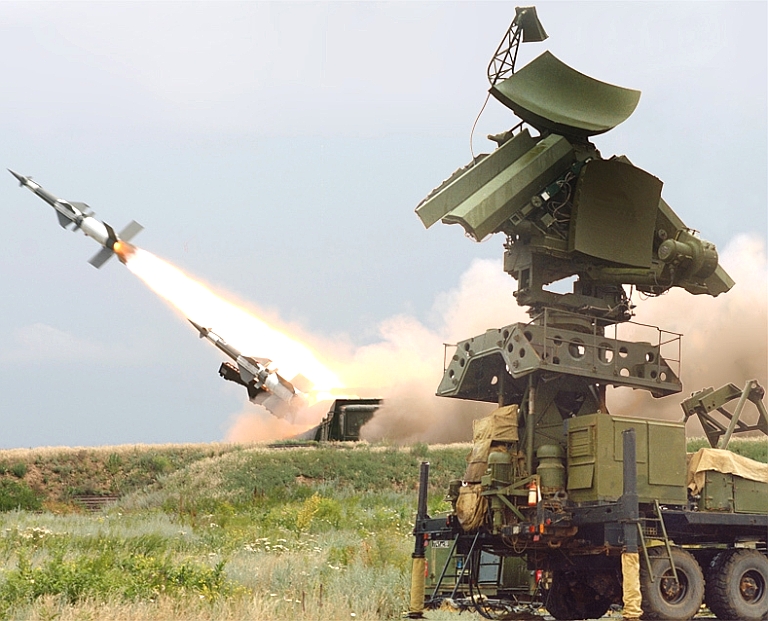
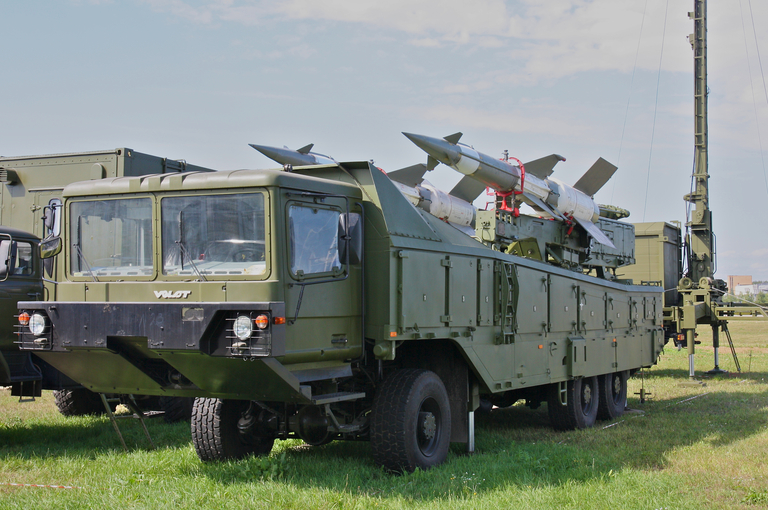
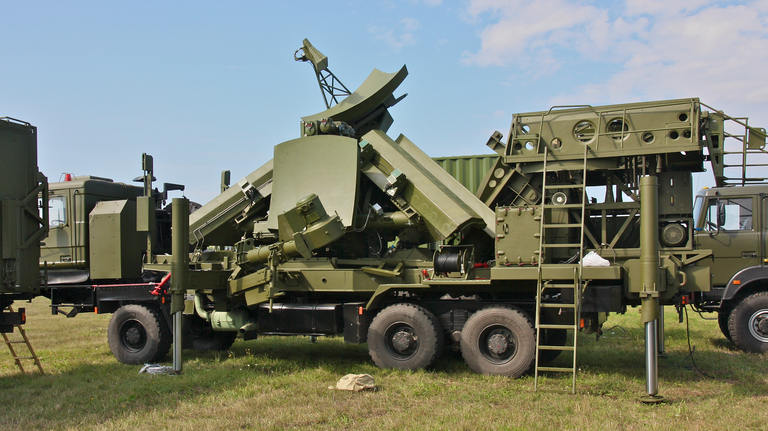
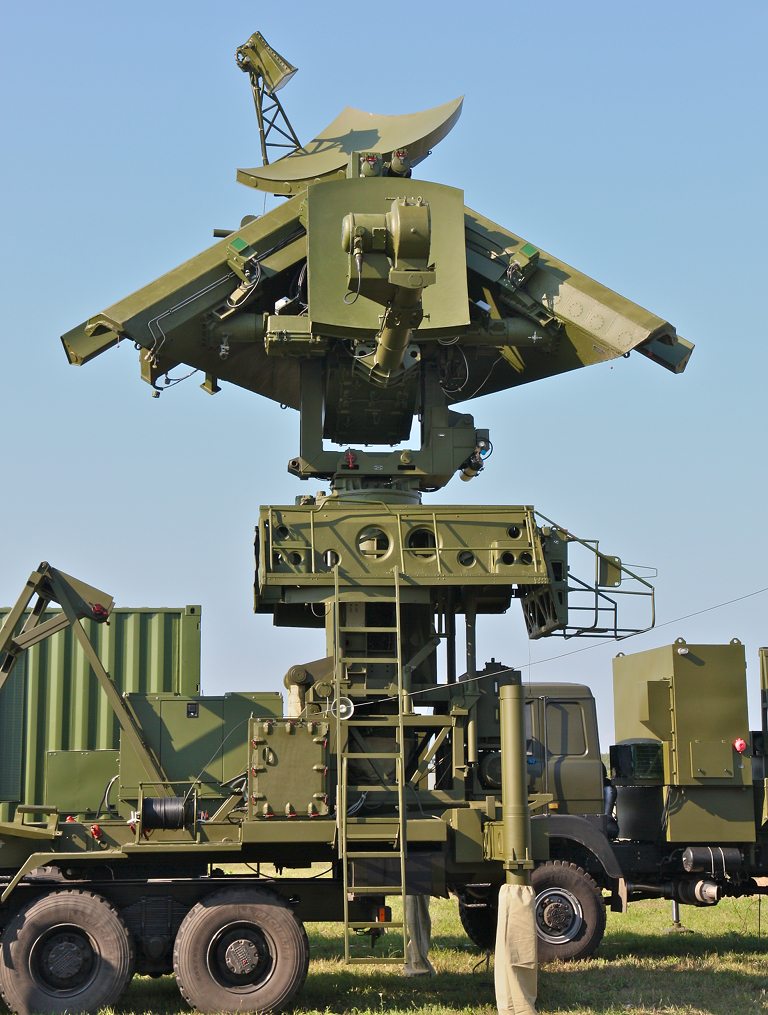
Annex A Defence Systems S-125-2M Pechora 2M [IMINT]
| MZKT-8022 Characteristics: | |
| Масса снаряженного шасси, кг: | 10000 |
| Полная масса шасси, кг: | 16000 |
| Масса перевозимого груза, кг: | 6000 |
| Допустимые осевые массы, кг: | |
| передняя ось: | 8000 |
| задняя ось: | 8000 |
| Максимальная скорость шасси полной массой, кг: | 60 |
| Минимальн. радиус поворота по оси след передн. наружн. колеса, м: | 12 |
| Двигатель дизельный: | ЯМЗ-236БЕ2-Т-6 |
| Мощность двигателя, кВт (л.с.): | 184 (250) |
| Гидромехан. передача с отбором мощн. для привода оборуд.: | Allison MD3560P |
| Запас хода по контр. расходу топлива, км: | 800 |
| Шины: | Michelin 525/65R20,5XS TL |
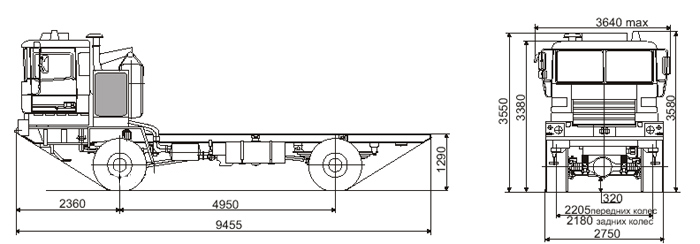
Almaz-Antey S-125-2A Pechora 2A Upgrade
Rosoboronexport Description (Cite):
- extension of ADMS engagement zone by introducing improved missile guidance methods;
- enhancement of target kill probability (including low-altitude targets) by improving SAM guidance accuracy;
- augmented capability to detect and track air targets in conditions of intensive jamming and passive interference, including meteoghosts and background clutter;
- improved ADMS performance in the TV/optical mode thanks to introduction of automatic target acquisition and tracking into the TV channel;
- improvement of operational characteristics, including partial automation of combat work; substitution of some units with up-to date hardware; upgrading of the crew training facilities; reduced volume and duration of scheduled maintenance works; enhancement of operational reliability; prolongation of service life; reduction of power consumption.
- SNR-125M-2A missile guidance radar comprising UNV antenna post, upgraded UNK-M2A control cabin and mobile repairs workshop
- air defence missile battery including up to four 5P73 launchers and up to 8 PR-14AM transporter-loader vehicles on wheeled chassis
- 5V27D SAMs
- electrical power supply system consisting of the RKU-N distribution cabin, 5E96A diesel-electric power station and 5E74M-230 mobile transformer unit
- The KU-03T cable layer with a set of cables can be delivered additionally.
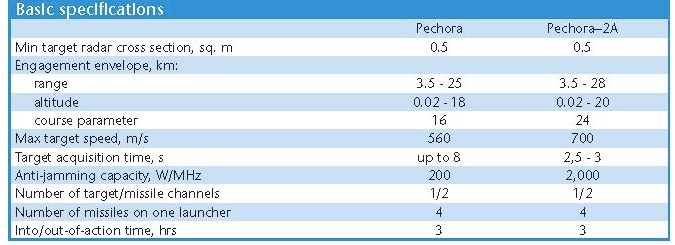
Cenrex Newa C/SC Upgrades
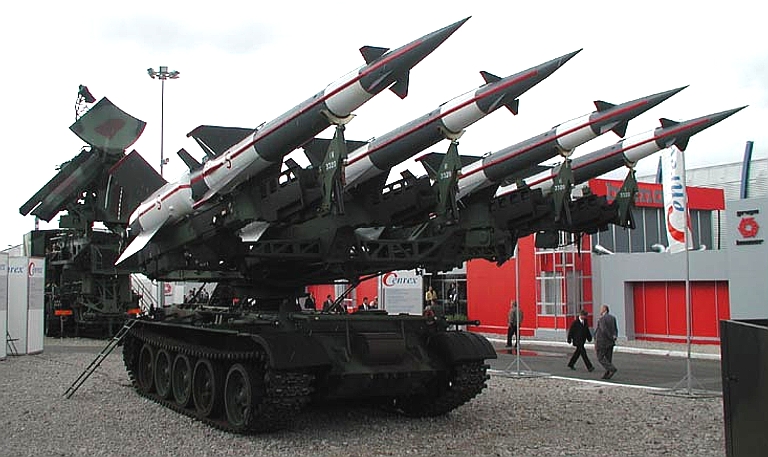
The second iteration was to rebuild surplus 9P117 Scud TELs, to carry both the SNR-125 radar and 5P73 launcher. The latter proved technically successful but the supply of local Scud TELs was not sufficient to support the Polish Army program, and a compromise using the tank chassis for the TEL and Scud launcher chassis for the radar was adopted. Polish sources claim the marketing of this upgrade to India was blocked by the Russian government.
The upgrade involves replacement of all legacy electronic hardware with digital COTS hardware and software.
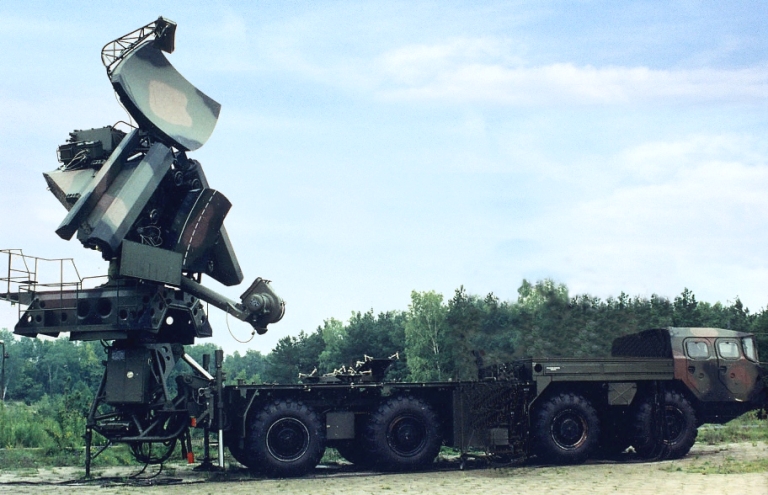
The Polish Newa-SC WNO-125SC upgrade sees the hitherto towed SNR-125 Low Blow carried by a MAZ-543 8 x 8 "Kashalot", salvaged from retired 9P117 Scud TELs. Upper image with C2 cabin removed. Additional images [1], [2] (Cenrex images, Tetraedr image below).

Cenrex Description (Cite):
- 100% digitalization of all electronic components;
- increased resistance against Electronic Countermeasures;
- the new Command and Control station (The original C2 station is scrapped);
- introduction of state of art computer technologies and components off the shelf (COTS) which are easily available on international market (so the device cannot be subject to international trade restrictions and limitations);
- new transmitters, with low peak power and less radiation, due to which the system is less detectable by an enemy;
- increased target hit probability resulting from the above mentioned improvements – more than 0.95;
- high mobility due to application of either tracked or wheeled chassis as an host vehicle (mode A/B);
- very short egress time – less than 15 minutes;
- very short setup time in a new location – less than 17 minutes;
- interfaces to higher level radar early warning systems available;
- guarantee by the Polish party to deliver the spare parts for replaced components for the period of next 10 years;
- technical assistance and support during modernization process and introduction into service;
- option of conducting the modernization in a client’s military overhaul depot with the involvement of a small group of the Polish experts and technicians;
- Wheeled/Tracked;
- Wheeled;
- Modernisation of the Command & Control Cabin with 125-SC Command System;
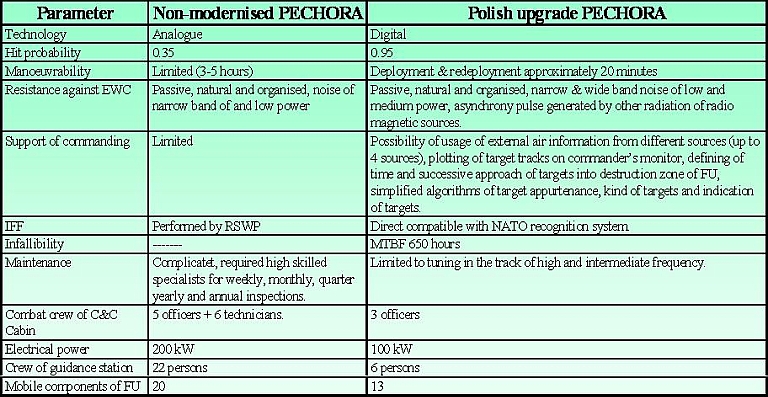
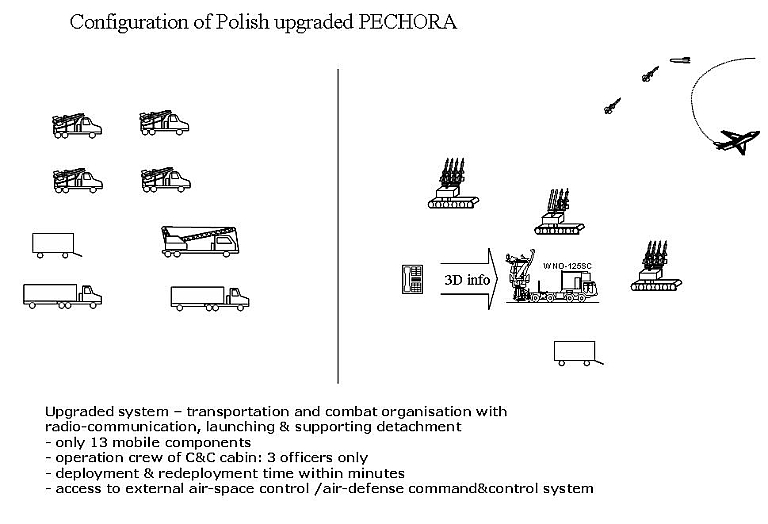
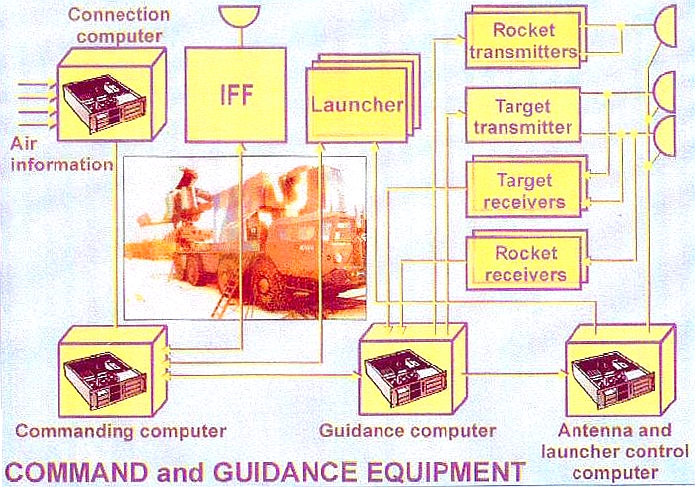
Uplink transmit/receive labelled as "Rocket", radar transceivers labelled as "Target".
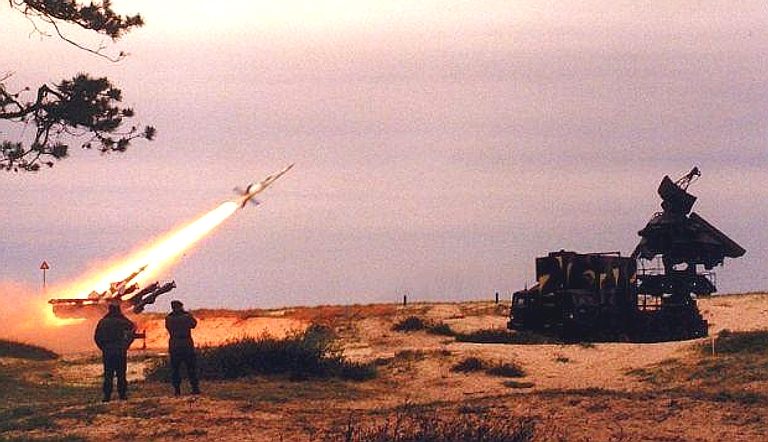
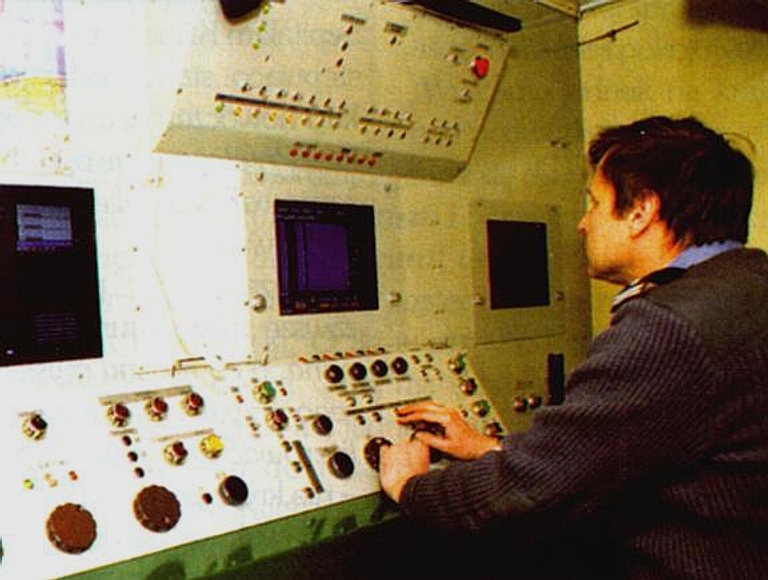
Newa-SC missileer console using LCD panels and COTS hardware (Cenrex).
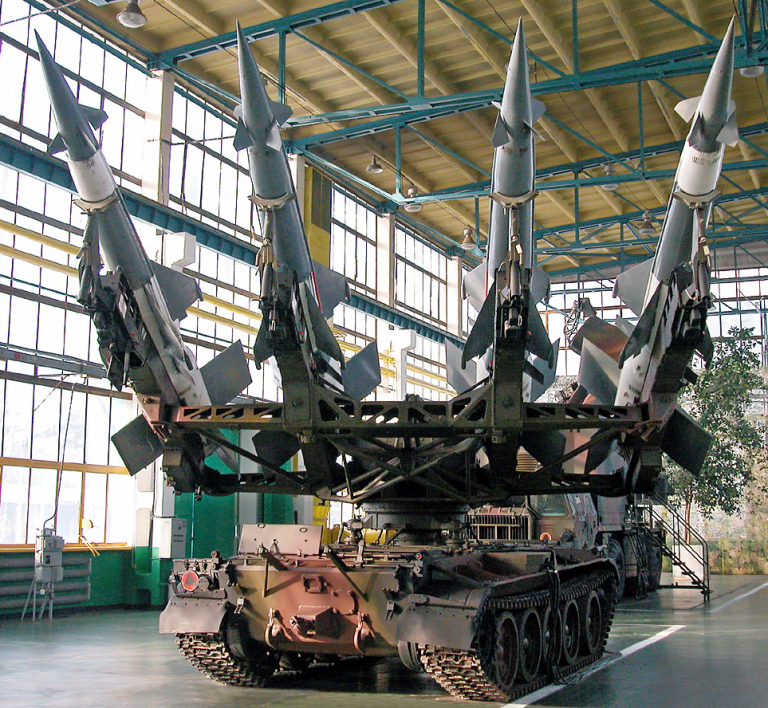
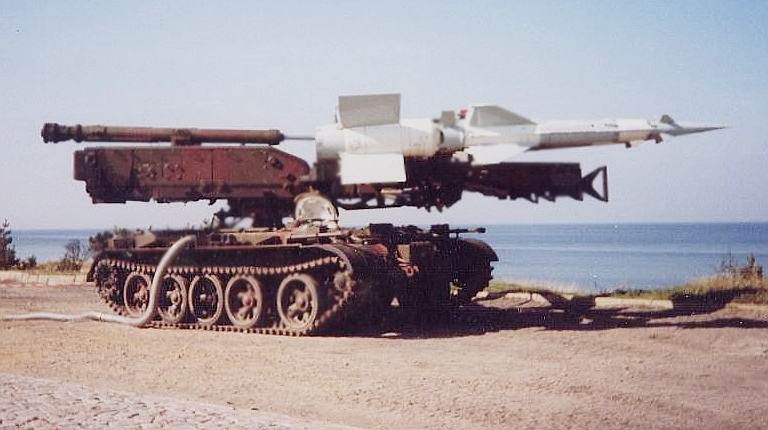
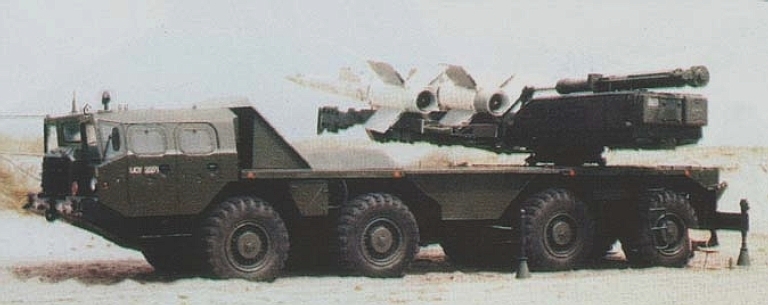
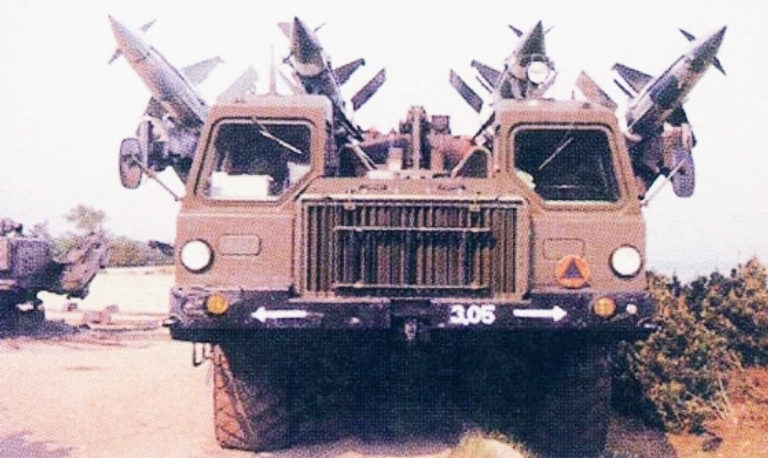
Cuban T-55 / 5P73 TEL
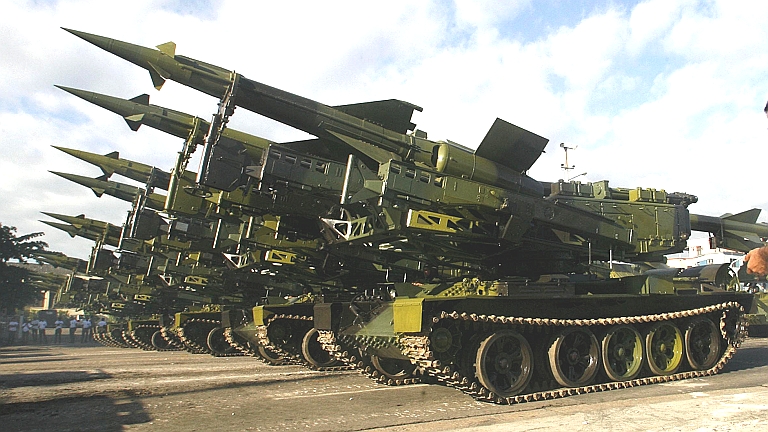
Cuban SA-3 TELs on display (via Vestnik-PVO).
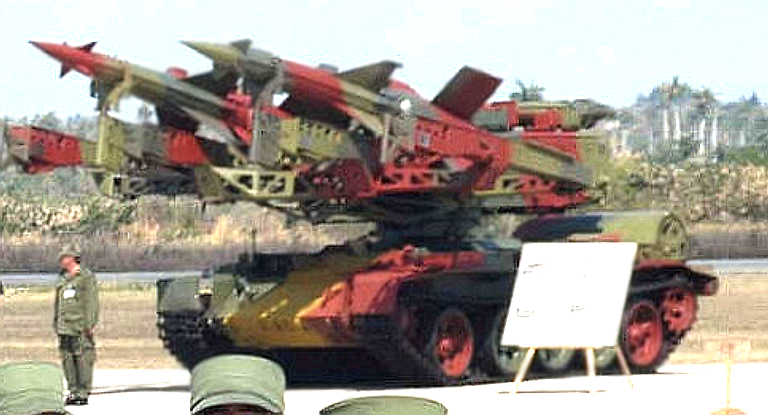
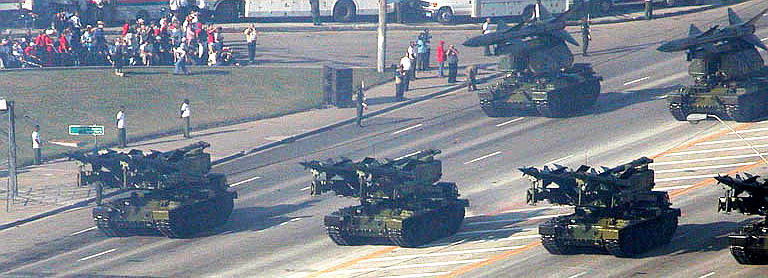
SA-3 TELs in foreground, SA-2 TELs in background (via Vestnik-PVO).
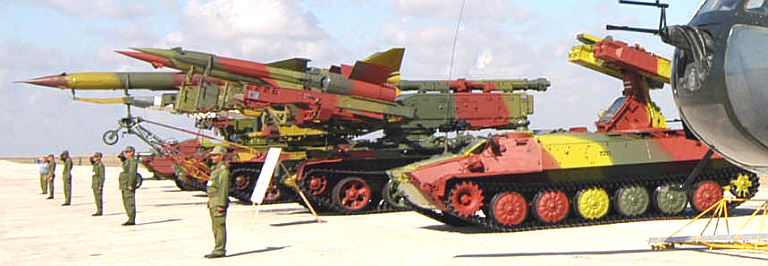
SA-2 TEL, SA-3 TEL and SA-13 Gopher on display.
S-200VE Vega/SA-5 Gammon SAM System Upgrades
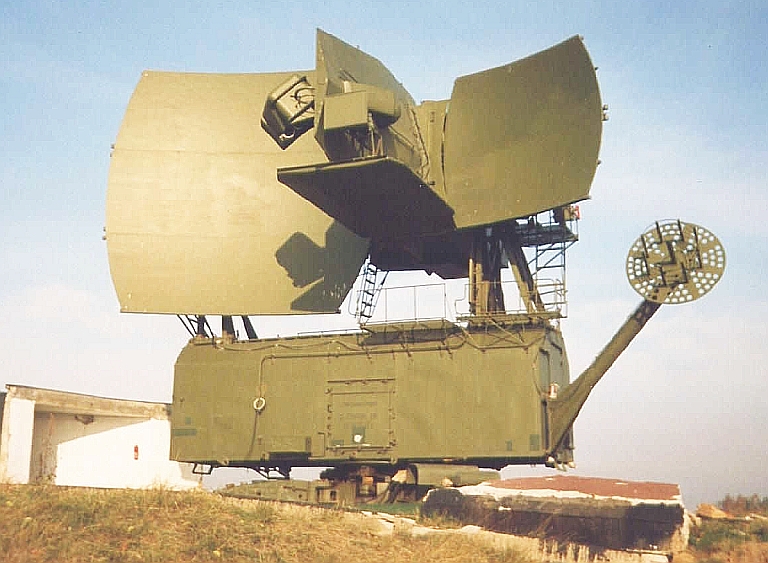
The legacy S-200 family of 160 nautical mile range class long range SAMs has been largely replaced in Russian service by more recent variants of the S-300PMU family of systems. Nevertheless the system is of some interest as it was exported to a number of Soviet client states, including Belarus, Uzbekistan, Bulgaria, the Ukraine, Czechoslovakia, Hungary, Poland, India, North Korea, Libya, Syria, and more recently Iran. Much of this proliferation occurred after the 1998 fire sale of former PVO-S warstock and inventory, as the S-200 was phased out of Russian service.
Upgrades are on offer, include a facility to hybridize the SA-5 with the SA-20 Gargoyle.
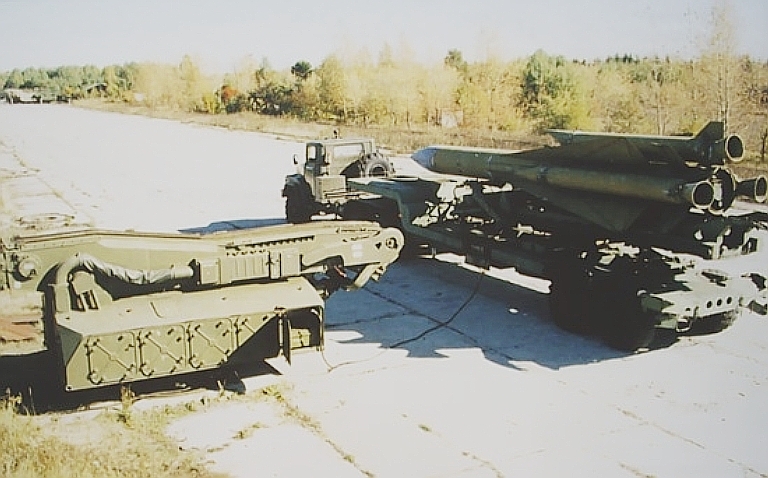
Almaz-Antey S-200 / S-300PMU1/2 Hybridisation Upgrade
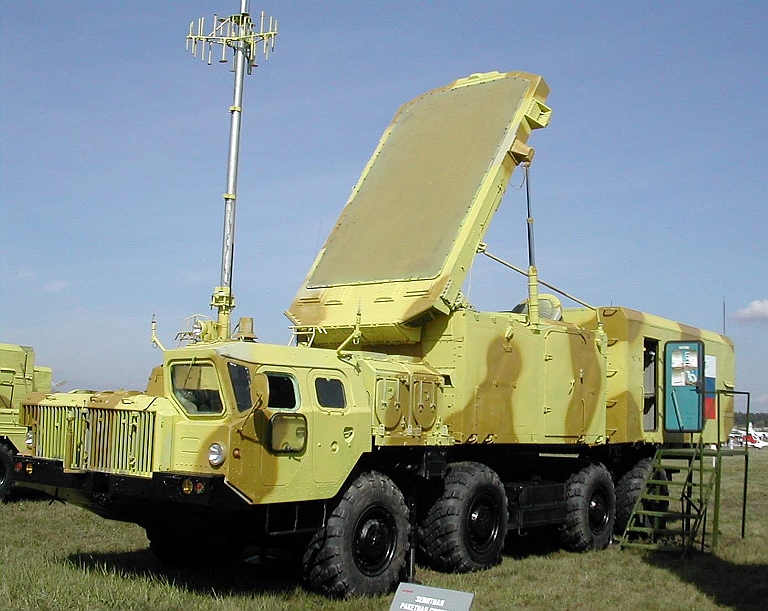
Interfaces and software are available for the S-300PMU2 Favorit / SA-20 Gargoyle and S-400 Triumf / SA-21 to control the S-200 Angara/Vega/Dubna / SA-5 Gammon and its 5N62 Square Pair engagement radar. In this arrangement, an SA-20/21 system with its high power aperture and highly jam resistant acquisition and engagement radars prosecutes an engagement, but rather than launching its organic 48N6 series missile rounds, it uses the SA-5 Gammon round instead.
The 5N62 Square Pair is effectively slaved to the 30N6E2 or 92N6E phased array engagement radar and acts as a specialised Continuous Wave illuminator, rather than long range target tracking and illuminating element of the battery. This model is analogous to the S-300V/SA-12 scheme, where the 9A82/83 TELARs with their CW illuminators are slaved to the 9S32 Grill Pan phased array engagement radar. The notion that any part of the cumbersome, slow and electronically vulnerable acquisition and tracking function of the Square Pair would be retained in the hybrid system makes no sense, and indeed it would nullify many of the benefits of using the hybrid in the first place.
This has important implications for future combat against users of this hybrid system. In the legacy SA-5 system, a search radar such as a Tall King or Bar Lock would cue the Square Pair engagement radar, which would search the area of interest with a narrow pencil beam in an automated spiral or raster pattern, or manually, until the target was acquired and tracked, upon which the SA-5 missiles with CW homing seekers were tuned to the CW carrier (in early variants) and then launched. As the 1980s skirmishes between the US Navy and Libyan air defences illustrated, US EA-6B Prowlers with their ALQ-99 jamming equipment were able to successfully disrupt tracking by the Square Pair and render the SA-5 missiles unusable.
In a hybrid SA-5/SA-20/SA-21 system, attempts to jam the Square Pair will be ineffective as it is functioning as a simple open loop CW illuminator and missile command uplink transmitter. Because the SA-5 is a static system, operators can precisely calibrate the Square Pair in azimuth and elevation, and given the availability of Glonass, GPS and satellite imagery, this calibration is neither expensive in time or resources. Once this has been performed it presents no difficulties for a Glonass/GPS equipped autonomous SA-20/21 battery to issue over a radio datalink launch and cueing commands to the SA-5 battery, and once the missiles have been launched, precision elevation and azimuth commands to the Square Pair to control illumination and missile uplink functions. Indeed, once such integration has been performed, it is an open question whether it would be even economical let alone operationally viable to retain the full SA-5 battery package of K-1, K-2, K-3 and K-9 trailers, as a rack of digital equipment installed in the Square Pair K-1/1M radar head trailer to provide interface and control functions would be cheaper to run and more effective in combat.
The challenge which a hybrid SA-5/SA-20/SA-21 system presents is considerable. The SA-20/21 battery is highly mobile, and with modern digital frequency hopping radars, will be difficult to jam. Soft kill and hard kill become problematic. In terms of defeating the SA-5 component of the hybrid, the only option is to jam the missile CW homing seeker, the effectiveness of which will depend entirely on the vintage of the 5G24N series seeker and the capabilities of the jamming equipment. If the customer opts for an upgrade to the seeker electronics, the seeker may be digital and very difficult to jam.
The hybrid SA-5/SA-20 option is available to nations using both of the SAM systems - a known instance being Iran.
Tetraedr/Almaz-Antey S-200VE Vega/SA-5 Gammon SAM System Upgrades
Tetraedr are offering a technology insertion upgrade for the S-200VE, in addition to the overhaul and zero timing of the 5V28VE missile round. It is not known whether this upgrade product has been exported to date.
The digital technology insertion upgrade is intended to increase the capabilities and reliability of the system. Specific improvements claimed are in countermeasures resistance and kinematic range, indicating the upgrade includes the 5G22/5G23/5G24 CW semi-active homing radar seeker.
Almaz-Antey are offering a similar upgrade package but have not disclosed any specific details to date.
2K12 ZRK Kub/Kvadrat/SA-6 Gainful SAM System Upgrades
Deployed initially during the late 1960s, the SA-6 has been subjected to a wide range of upgrades, as a result of which many different configurations exist, including hybrids with the subsequent 9K37 Buk series. In Soviet service it was replaced primarily by the 9K37/M/M1 Buk/Buk-M/M1 (SA-11 Gadfly).
Numerous upgrades exist for the 2K12 SAM system. Some users have fitted optical trackers to the Straight Flush. Agat have developed the 9B-1103M-350 active radar seeker, based on the RVV-AE / AA-12 "AMRAAMski" seeker, as a retrofit for the 9M9 SAM round. The larger antenna permits acquisition of a 5m2 target at 40 km range.
The proposed Czech Army RETIA upgrade to the 1S91 includes COTS digital hardware and software, a solid state exciter for the magnetron transmitters, a fully digital coherent receiver with 75 dB dynamic range, and an optical tracker.
Egypt is reported to have procured an SA-6 upgrade replacing the legacy boosted ramjet 3M9 rounds with the SA-17 9M317E Grizzly round.

Iraqi 3M9/R-60 Hybrid Heatseeking Gainful Round
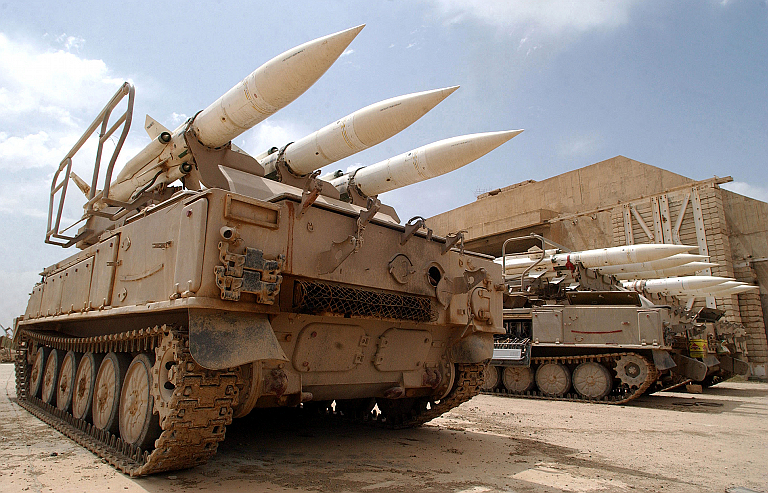
An Iraqi 2K12 Kvadrat / SA-6B Gainful SAM system captured by US troops in 2003, in storage near Baghdad. Standard 3M9 CW SARH guided rounds are loaded (US DoD image).
Perhaps one of the most interesting finds during the 2003 OIF invasion of Iraq were examples of the indigenous hybridisation of the 3M9 SAM round with the seeker section from the Molniya/Vympel R-60 / AA-8 Aphid heatseeking air to air missile, procured during the Cold War to arm Iraq's numerous Soviet supplied fighters. The motives for this development effort were clear - Coalition jamming of the CW seeker on the 3M9 missile round during Operation Northern/Southern Watch rendered the standard missile round ineffective. The intent was to produce an electronic countermeasures resistant variant of the missile with infrared terminal homing rather than CW semi-active radar homing. The basic 3M9/9M9 Gainful round is flown through its midcourse phase by command link from the 1S91 Straight Flush, using a tracking beacon in the tail of the missile.
The most detailed public description of the design was produced by Doug Richardson, Editor of Janes Missiles and Rockets, in his April 23, 2003, article “Iraqi heat-seeking Gainfuls found”. Some imagery also emerged during that period.
It would appear that Iraqi engineers stripped down R-60/60M rounds from remaining post 1991 warstocks to remove the OGS-60TI “Komar” / OGS-75 “Komar M” seeker section, which was installed in a re-engineered front section for the 3M9 fuselage, with a conical fairing and Aphid nose replacing the original guidance section containing the 1SB4 series CW SARH seeker. Adaptor hardware would be required to match the analogue pitch/yaw outputs from the R-60 seeker. The R-60 OGS-60TI “Komar”, and OGS-75 “Komar M” seekers, built by Arsenal in the Ukraine, are conventional single colour scanning detector designs with a cited ±12° off-boresight capability, ±17-20° in the later OGS-75 “Komar M” variant, and a 35°/sec tracking rate. The all aspect R-60M is credited with a 42 G capability. Overall the later model Komar M seeker compares closely to the US AIM-9L Sidewinder “all aspect” seeker.
While the resulting heatseeking 3M9 round would retain similar susceptibility to flares or more recently, infrared jammers, the missile engagement sequence would be devoid of the CW illumination for the terminal phase of the missile's flight, as a result of which aircraft under attack only have the command uplink signals and terminal phase 1S91 tracking signals to warn of an approaching missile. Where the defensive countermeasures suite relies on the CW signal to trigger angle/range jamming, the heatseeking 3M9 could be potentially very effective.
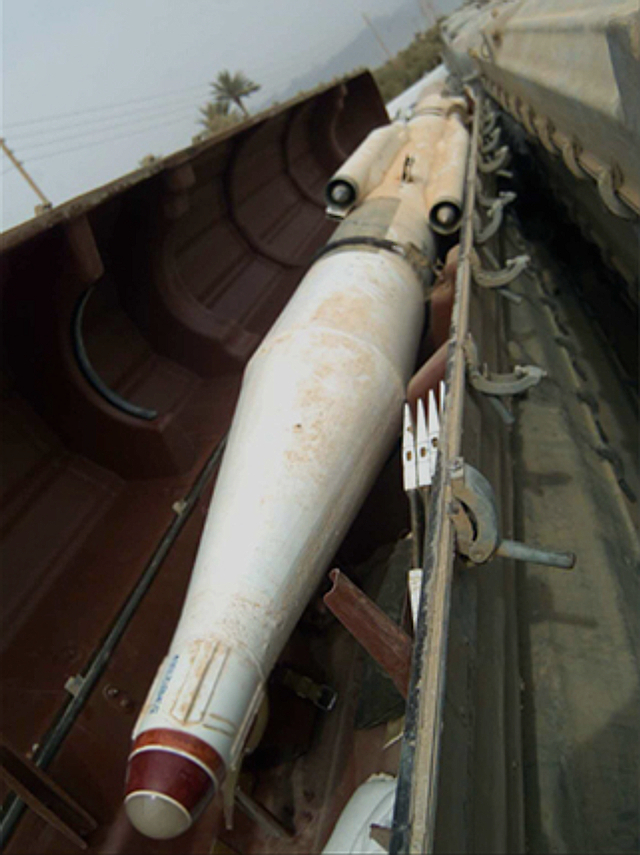
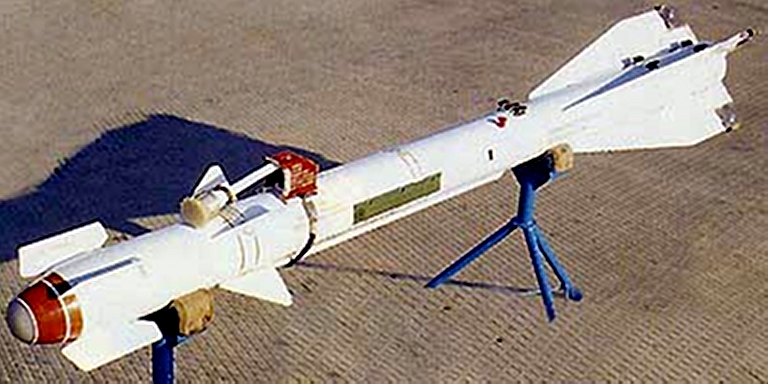
Vympel/Molniya R-60 Aphid AAM (uncredited Russian internet image).
Kvadrat Air Defence Missile System Modernisation (1st stage)
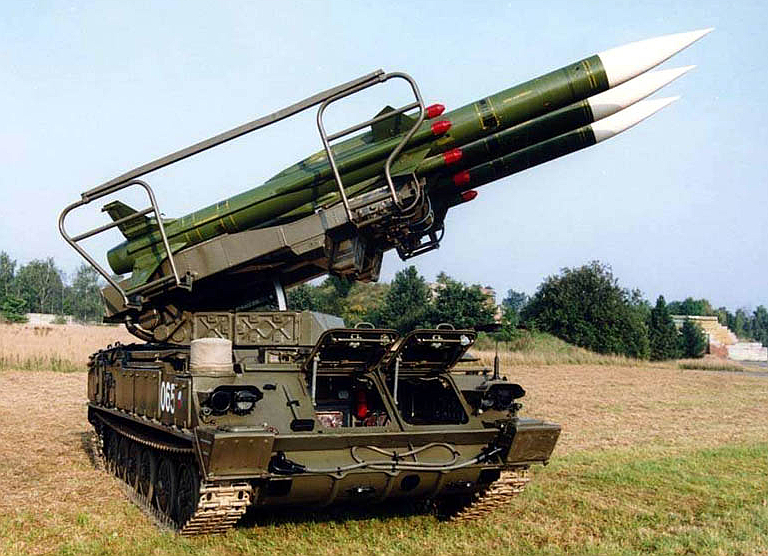
2P25 TEL with three 3M9 Gainful rounds loaded (Czech Army).
Rosoboronexport Description (Cite):
The modernised Kvadrat medium-range air defence missile system is designed to defend friendly troops and installations against modern high-speed manoeuvring strategic and tactical aircraft, as well as against attack helicopters and cruise missiles, under conditions of mass attack, in hostile electronic countermeasures and fire counteraction environment.
Scope of modernisation
The upgrading of the Kvadrat ADM system envisages modification of:
(a) the 1S91 Straight Flush surveillance and guidance radar post:
- replacement of the analogue Moving Target Indicator system with a digital one, featuring increased clutter rejection of up to 28-30 dB;
- introduction of the tracked target classification system (aircraft, helicopter, cruise missile and other classes of air targets);
- extension of the CW illumination channel bandwidth from 6 to 12 selectable frequencies;
- replacement of vacuum tube RF amplifiers with solid-state ones, including substitution of their high-voltage power units for low-voltage ones, as well as introducing new electronic components;
- replacement of the cathode-ray tube displays with colour LCDs, which notably increases the amount of data displayed and extends service life (up to 10,000 - 15,000 hours), and also reduces power consumption and the number of operating adjustments;
- introduction of testing and monitoring system providing real-time recording with subsequent playback of all data on operation of the ADMS major elements including radar, launcher and missiles.
A follow-on modernisation of the Kvadrat ADMS envisages considerable improvement of its combat capabilities by introducing some of the elements of the advanced Buk M1-2 / SA-17 Grizzly medium-range ADMS.
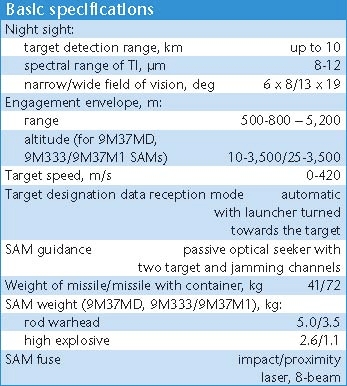
Tikhomirov NIIP Kub/Kvadrat Upgrade
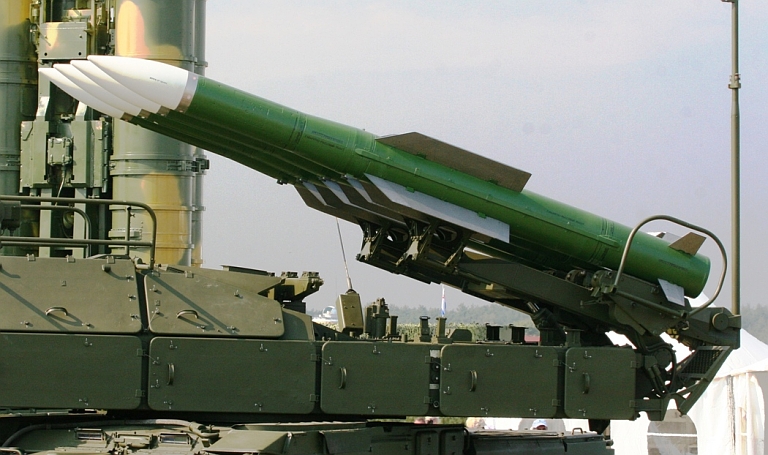
The second stage NIIP upgrade involves replacement of the legacy 2P25 TELs with the 9А310-М1-2 TELAR from the late model 9K37M1-2 Buk M1-2 / SA-11 Gadfly system and the 3M9 series SAM with the 9М317 / SA-17 Grizzly SAM (upper image © Miroslav Gyűrösi, lower image Olli-Jukka Paloneva via Wikipedia).
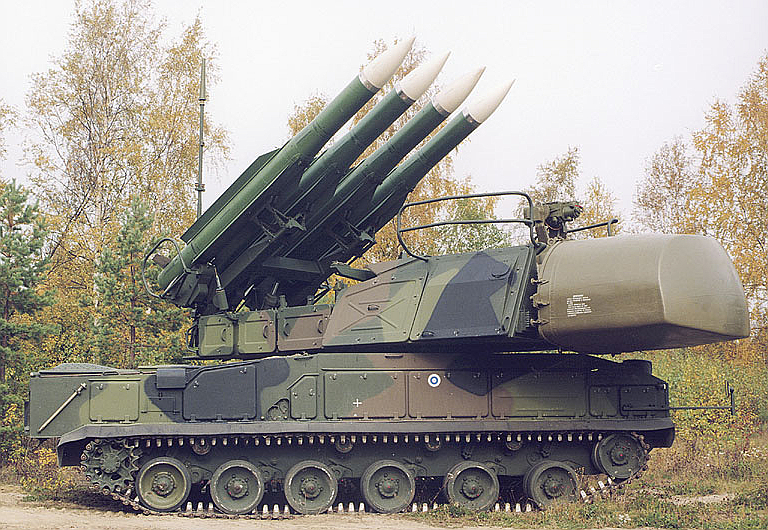
Tikhomirov NIIP, the original designers of the 2K12 / SA-6 system, are offering a two stage technology insertion upgrade to the baseline design.
The first stage upgrade includes a series of subsystem replacements in the 1S91M1/M2 Straight Flush engagement radar:
- Replacement of the CW illuminator to increase the number of alternate frequencies from 6 to 12, and to improve jam resistance and reliability.
- Replacement of the legacy analogue MTI system with a DMTI to improve clutter rejection and jam resistance.
- Add a Non-Cooperative Target Recognition (NCTR) capability against fixed wing, rotary wing and missile targets.
- Replacement of the thermionic receiver chain with a fully solid state transistor design.
- Replacement of the legacy CRT displays with AMLCD panels.
- Replacement of the analogue fire control computer with a digital processor.
- Addition of a modern digital wireless network connecting battery components and providing access to external data sources.
| Основные
тактико-технические
характеристики ЗРК "Квадрат" с СОУ ЗРК
"БУК-М1-2" Principal tactical / technical characteristics of the Kvadrat SAM system with the Buk-M1-2 TELAR |
||
| Наименование
параметров Parameter |
С ЗУР
3М9М3 (3М9М) With 3М9М3 (3М9М) SAM |
С СОУ
9А310-М1-2 и ЗУР
9М317 With 9А310-М1-2 TELAR and 9М317 SAM |
| Зона поражения
аэродинамических
целей: Engagement envelope for aerodynamic targets: |
|
|
| - по дальности (км) - in range [km] |
4 -25 | 3 -42 |
| - по высоте (км) - in altitude [km] |
0,03 -14 | 0,015 -25 |
| Максимальная
скорость поражаемых
целей: Maximum velocity of defeated targets: |
|
|
| - приближающихся
(м/сек) - closing [m/s] |
600 | 1200 |
| - удаляющихся
(м/сек) - receding [m/s] |
300 | 300 |
| Вероятность
поражения цели
одной ракетой: Single Shot Pk |
|
|
| - аэродинамические
цели и вертолёты - aerodynamic targets and helicopters |
0,8-0,9 | 0,8-0,95 |
| - зависающие
вертолёты - helicopters in hover |
– | 0,4 |
| Максимальные
перегрузки поражаемых целей Maximum load factor of defeated targets [G] |
7-8 | 10-21,5 |
| Количество целевых
каналов Number of concurrent engagements |
1 | 2 (1 цель- СОУ, 1
цель- СУРН) 1 by Straight Flush, 1 by TELAR |
| Стартовая масса
ЗУР
(кг) SAM launch mass [kg] |
670 | 720 |
| Вес боевой части
ЗУР (кг) SAM warhead mass [kg] |
57 | 70 |
| Время
развёртывания с марша (мин) Setup time [min] |
5 | 5 |
| Способ
наведения
ЗУР SAM guidance method |
полуактивное
самонаведение semiactive homing |
|
| Source: Tikhomirov
NIIP |
||
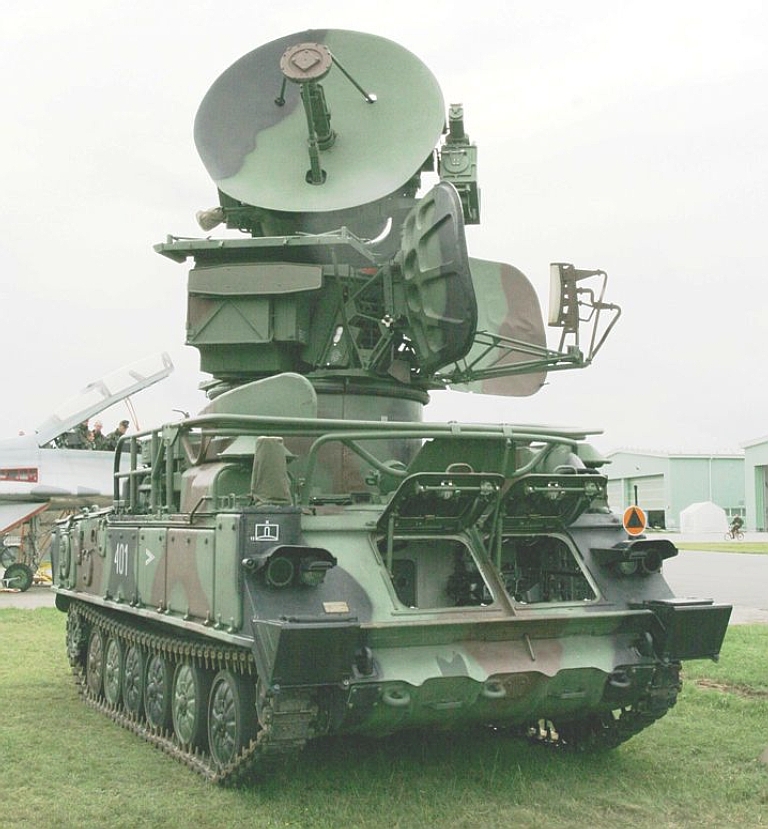
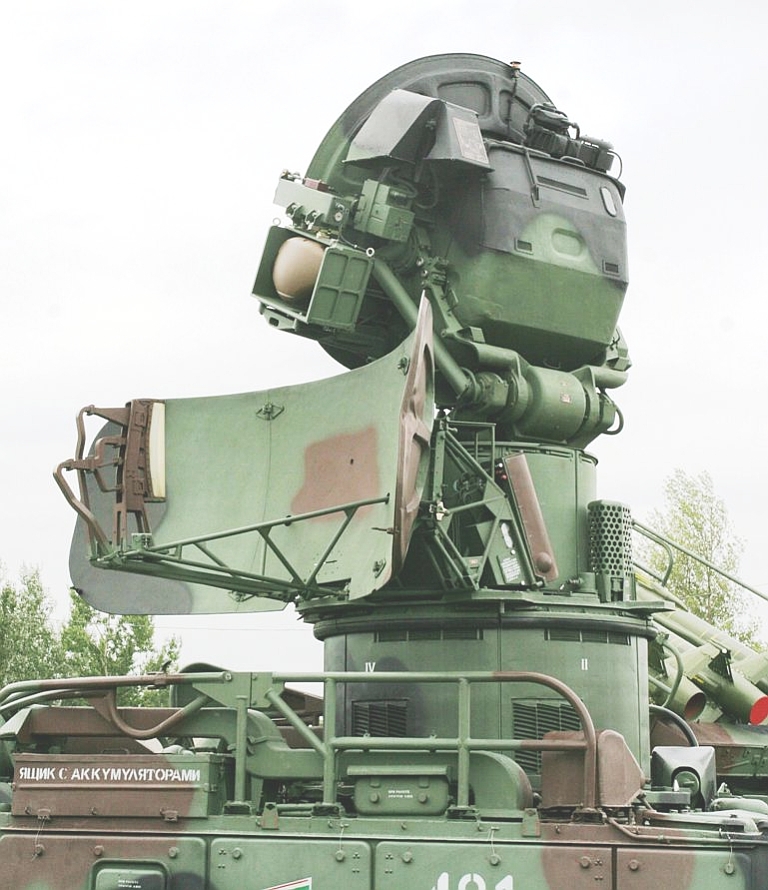
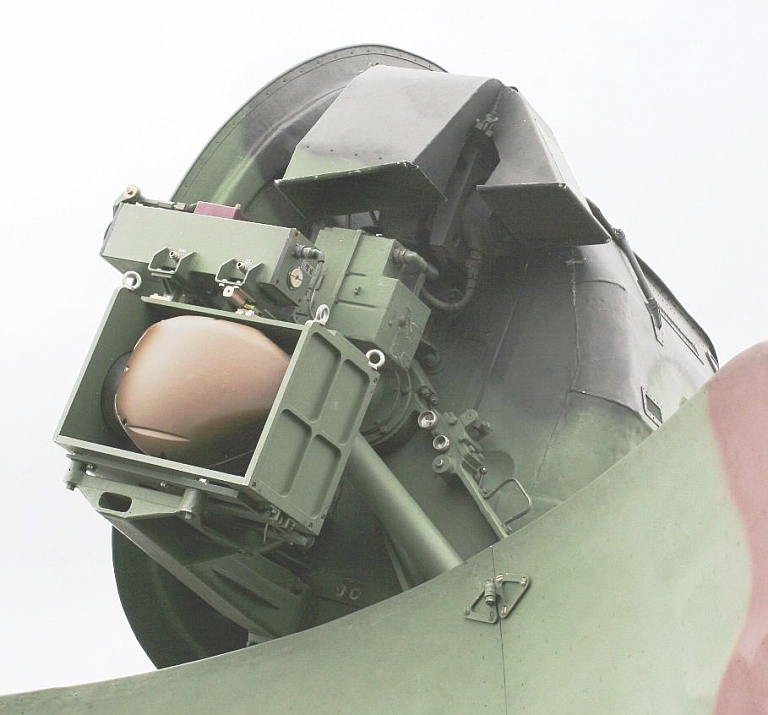
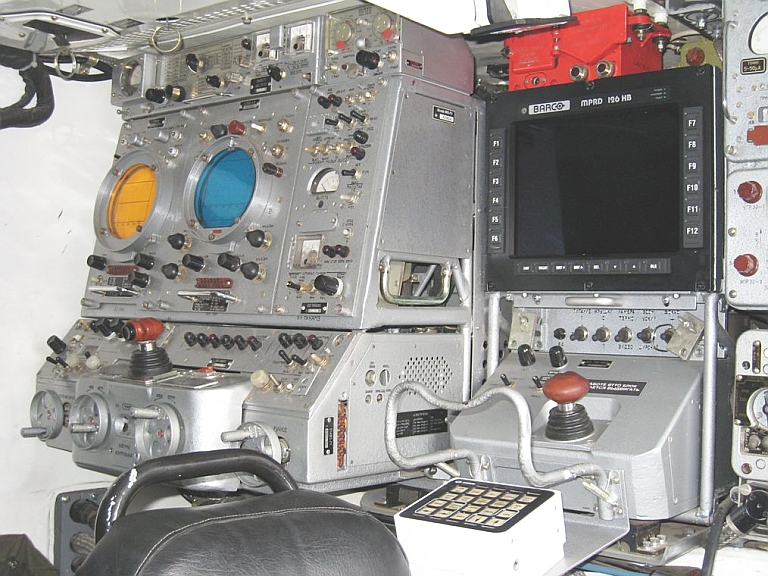
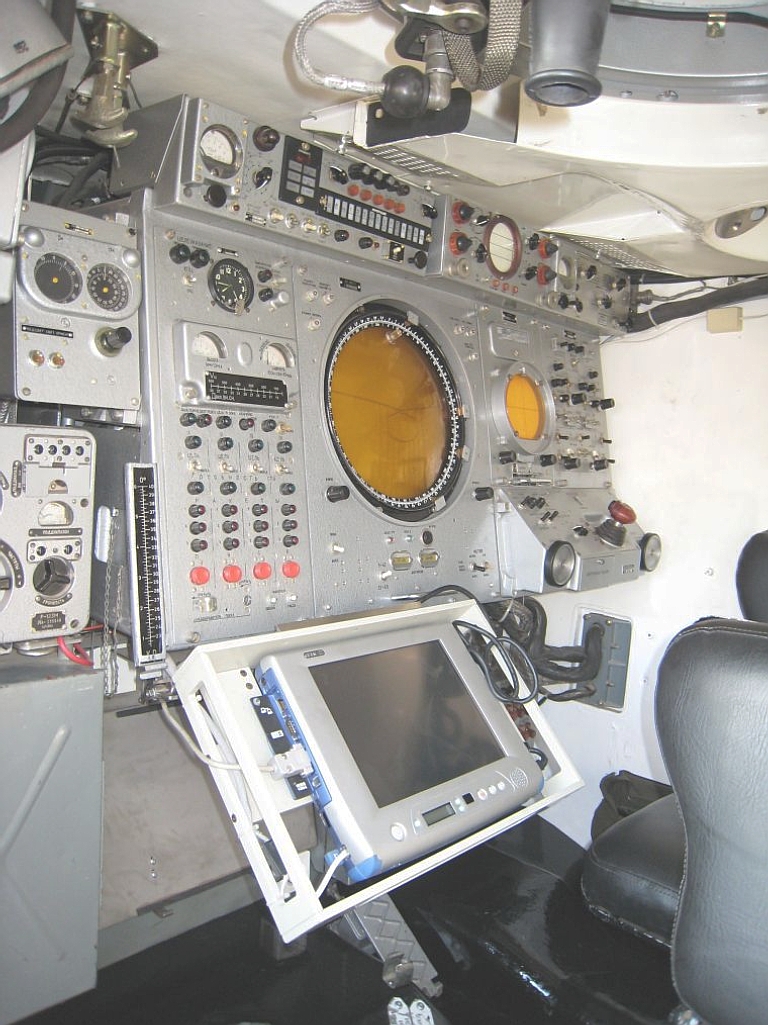
Czech Republic Army SURN CZ Upgrade
The Czech Army has performed a comprehensive rebuild of their 1S91 Straight Flush radars under the SURN CZ effort. The replacement RF stages are all fully solid state and the operating frequencies have been changed. All systems are fully digital, and the crew complement is reduced to an operator, a commander and a driver.
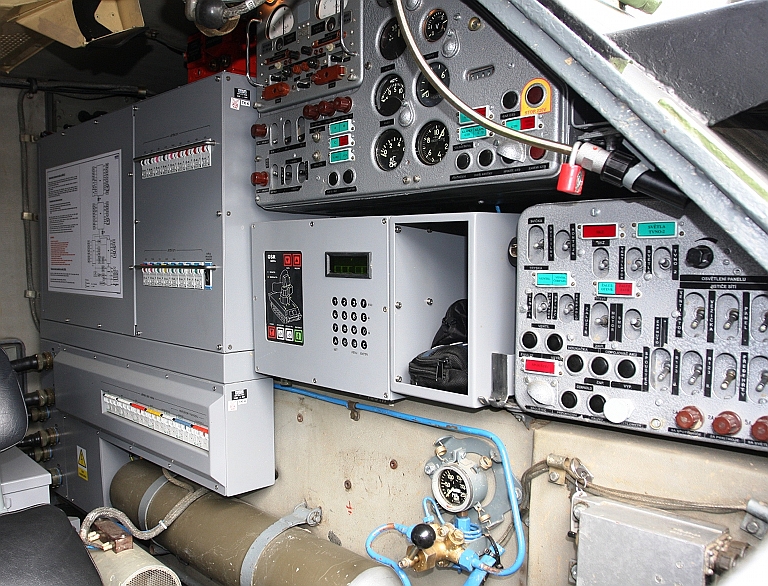
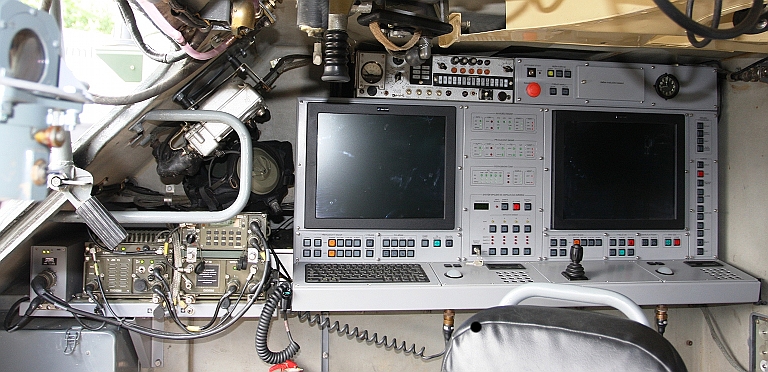
9K33/9K33M2/M3
Osa/Romb /
SA-8 Gecko SAM System Upgrades
Given the large operator base, the Gecko is an attractive target for upgrades. JSC Kupol in Russia offer the Osa AKM upgrade, and Tetraedr in Belarus the Osa 1T upgrade.
Agat have also proposed the miniaturised 9B-1103M-150 active radar homing seeker as a retrofit for the 9K33M3 / SA-8B Gecko missile round. The intent is to provide a salvoed fire-and-forget capability against multiple targets, supplanting the CLOS command link guidance, and better jam resistance for the weapon system.
JSC Kupol Osa-AKM Upgrade
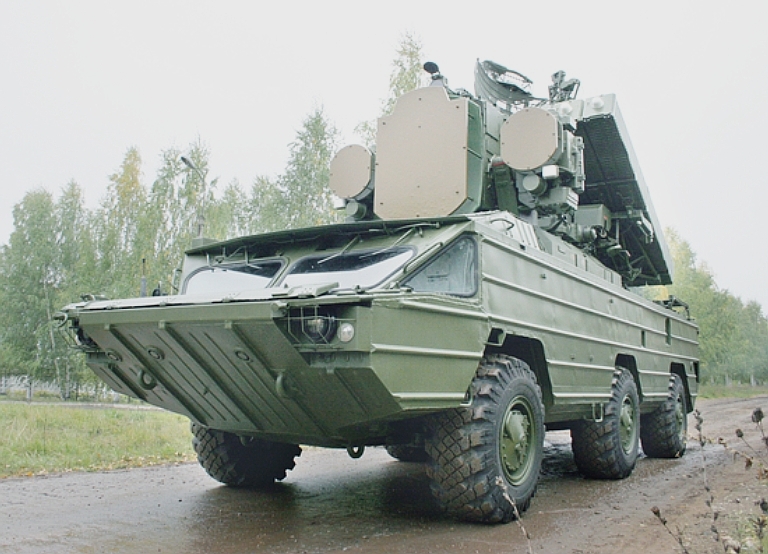
Osa-AKM is an autonomous self-propelled all-weather short-range ADMS. Each combat vehicle mounts radar, optical and computer systems, launching units with missiles, and power supply unit on the amphibious chassis. Their integration assures autonomous operation, including missile launches while on the move (one-two missiles against one target from a short halt).
A group of combat vehicles can be controlled by means of existing control posts such as PU-12M7 and PPRU-M1.
Composition
The combat assets include:
- up to four 9A33BM3 (9A33BM2) TELARs in one battery;
- up to six 9M33M3 (9M33M1) SAMs in the transporter-launcher containers on each TELAR.
- transporter/loader vehicle on amphibious wheeled chassis (up to 12 missiles);
- TELAR servicing and adjustment means, automated integrated missile test and monitoring, a group set of spare parts, tools and accessories, ground support equipment set;
- autonomous simulator for TELAR operators.
Modernisation programme
Modernisation of the Osa-AKM ADMS aims to increase combat and information capabilities of the system by introducing:
- telecoded datalink into the combat vehicle to automate control procedures, target designation data reception and two-way data exchange with the PU-12M7 or PPRUM1 control posts at a distance of up to 5 km on the move and in station;
- Mk-X/Mk-XII IFF interrogator on the TELAR;
- TV/optical viewfinder with an electro-optical system based on low-light/thermal-imaging devices;
- SAM’s warhead with 25% enhanced lethality;
- improvements of the crew's habitability conditions.
| Сравнительные
характеристики
ЗРК
«Оса»,
«Оса-АК» и «Оса-АКМ» Comparative Characteristics of the Osa, Osa-AK and Osa AKM |
|||||||
| Principal
Manufacturer |
Основной разработчик | НИЭМИ | |||||
| Year
of
Service
Acceptance |
Год принятия на вооружение | 1972 | 1975 | 1980 | |||
| Engagement
Range,
km |
Зона поражения по дальности, км | 2-9 | 1,5-10 | 1,5-10 | |||
| Engagement
Altitude,
km |
Зона поражения по высоте, км | 0,05-5 | 0,025-5 | 0,025-5 | |||
| Курсовой параметр, км | 4-6 | до 6 | до 6 | ||||
| Single
Shot
Kill
Probability |
Вероятность поражения одной ЗУР | |
|
||||
|
aircraft |
самолета | 0,35-0,85 | 0,5-0,85 | 0,5-0,85 | |||
|
helicopter |
вертолета | 0,3-0,4 | до 0,45 | 0,6-0,85 | |||
|
cruise
missile |
КР | до 0,4 | до 0,4 | до 0,6 | |||
|
ballistic
missile |
БР | - | - | - | |||
|
UAV |
ДПЛА | до 0,7 | до 0,8 | до 0,8 | |||
| Maximum
target
speed,
m/s |
Максимальная скорость цели, м/с | до 420 | до 500 | до 500 | |||
| Reaction
time,
sec |
Время реакции, с | 26-34 | 26-34 | 26-34 | |||
| System
weight,
kg |
Масса БМ, кг | около 1900 | около 1900 | 18680 | |||
| Missile/warhead
weight,
kg |
Масса ЗУР/БЧ, кг | 128/15 | 128/15 | 128/15 | |||
| Deployment/stow
time,
min |
Время перевода в боевое/походное положение, мин | 3-5/3-5 | 3-5/3-5 | 3-5/3-5 | |||
| Maximum
road
speed,
km/h |
Максимальная скорость движения, км/ч | до 80 | до 80 | до 80 | |||
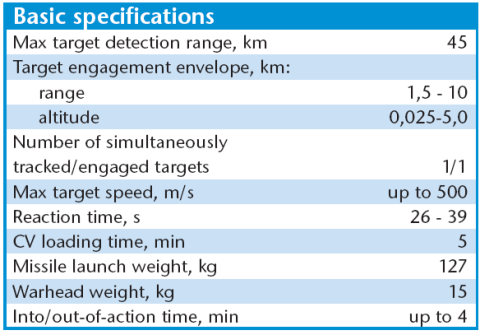
Tetraedr Osa-1T Upgrades
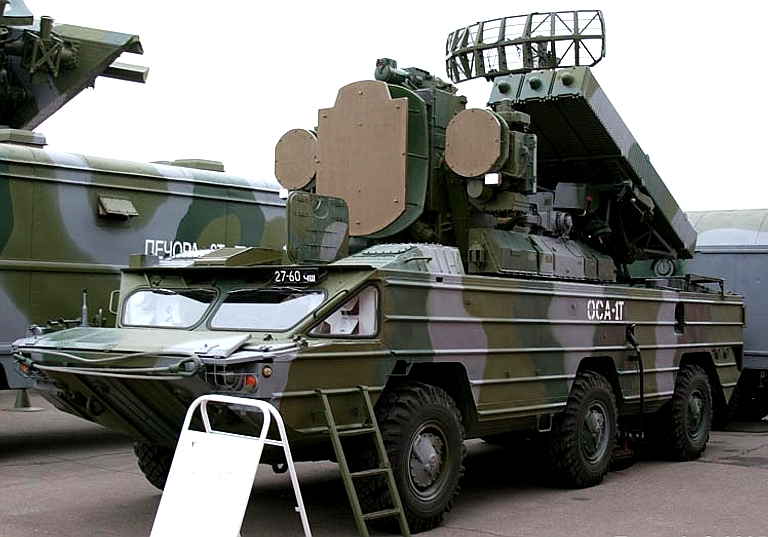
Tetraedr have developed the Osa-1T upgrade package for the SA-8 Gecko, exploiting earlier upgrade technology developed for the command link guided SA-3. The upgrade includes digitisation of the legacy analogue Land Roll components, new control laws to improve kinematic performance.
Tetraedr's Osa 1T upgrade recently underwent a redesign, to replace the legacy BAZ-5937 TELAR with a lightened derivative of the new ByeloRussian MZKT-69222, previously used in the latest Tor M-2/M2E / SA-15 Gauntlet variant. More affordable to operate and offering better mobility than the legacy BAZ, the new MZKT-69222 based Gecko TELAR is redesignated the 9A6922-1T. As of the end of 2008 Tetraedr had three contracts for the Osa 1T upgrade, one involving retention of the legacy TELAR chassis, and two involving rehosting the system to the MZKT-6922, with the total quantity at 80 TELAR rebuilds. The Osa 1T upgrade includes a revised crew station design and a new electro-optical targeting subsystem.
Tetraedr Description (Cite):
The "OSA-1T" ADMS is intended for fighting contemporary and future aerial attack assets under complex jamming conditions. The "OSA-1T" ADMS enables efficient defeat of low-altitude and small-size targets under all types of jamming.
The principal distinctions of the "OSA-1T" ADMS from the base-line configuration of the "OSA-AKM" ADMS are as follows:
Enhanced combat capabilities of the ADMS: The "OSA-1T" ADMS owing to its innovative effective SAM guidance system, is capable of killing manned and unmanned air attack assets at ranges of up to 12 km and altitudes of up to 7 km, flying at velocities of up to 700 m/s.
Combat operation automation: To automate the solution of the task related to the computation of kill zones of the target tracked in the real time and to reduce the system's response time every combat vehicle of the "OSA-1T" is equipped with a combat crew commander's automated workstation.
Enhanced ADMS reliability: 55% of the "OSA-1T" ADMS instrumentation has been converted to new hardware elements as against the base-line "OSA-AKM". The ADMS equipment reliability and service life have been increased; technical maintenance time and spare parts' nomenclature have been reduced. Training simulator 9F632, installed on a type ZIL-131 automobile chassis, has been completely discarded from the composition of the "OSA-1T" ADMS. Its functions are carried out by the training simulator, made as an independent unit and installed in every combat vehicle of the system.
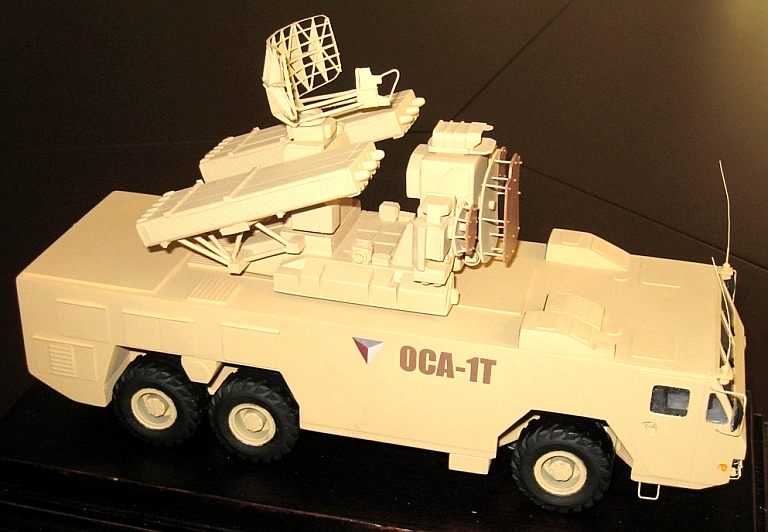
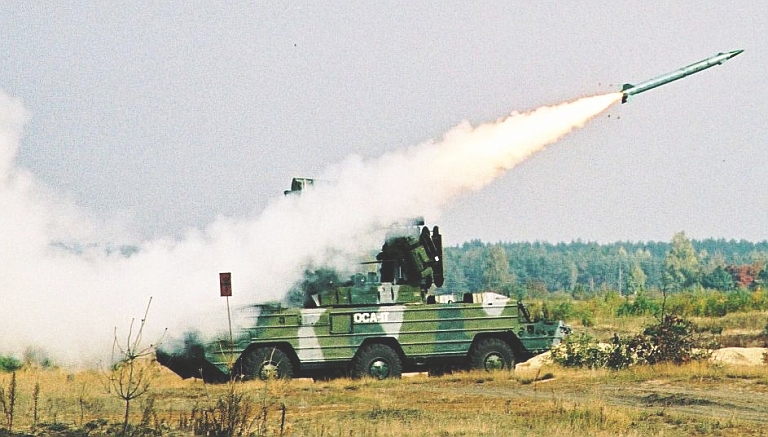
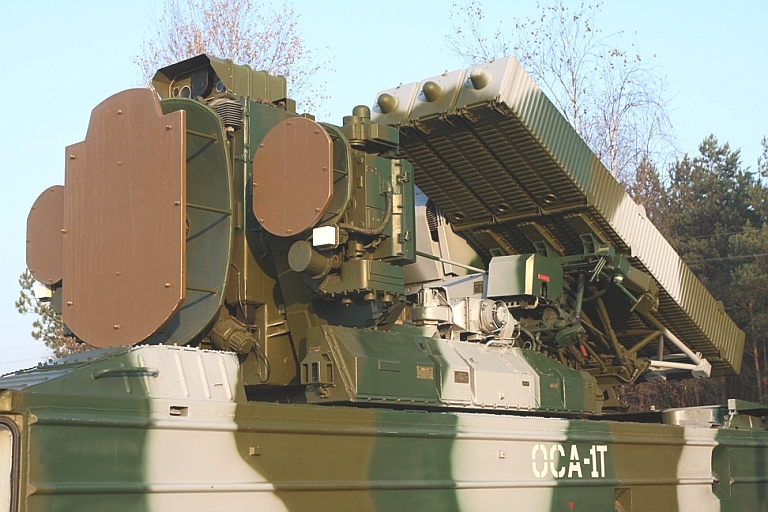
Osa 1T updated Land Roll radar package (image © Miroslav Gyűrösi).
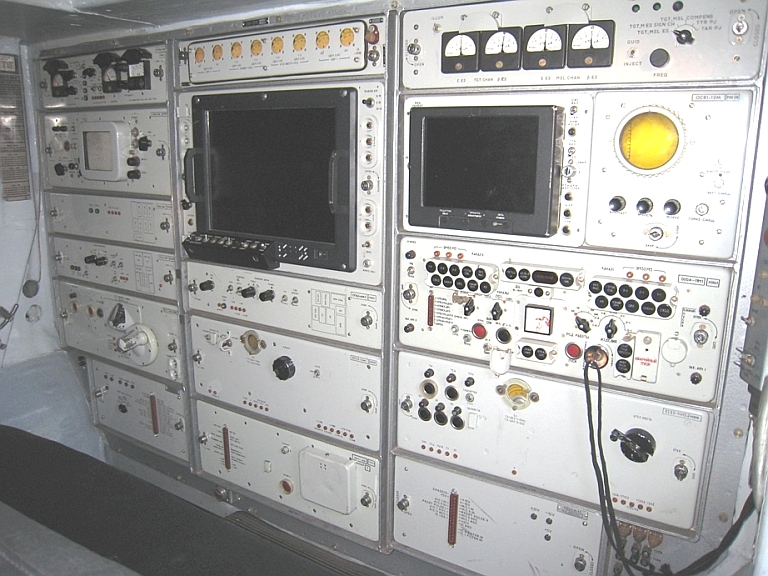
Osa 1T crew station (image © Miroslav Gyűrösi).
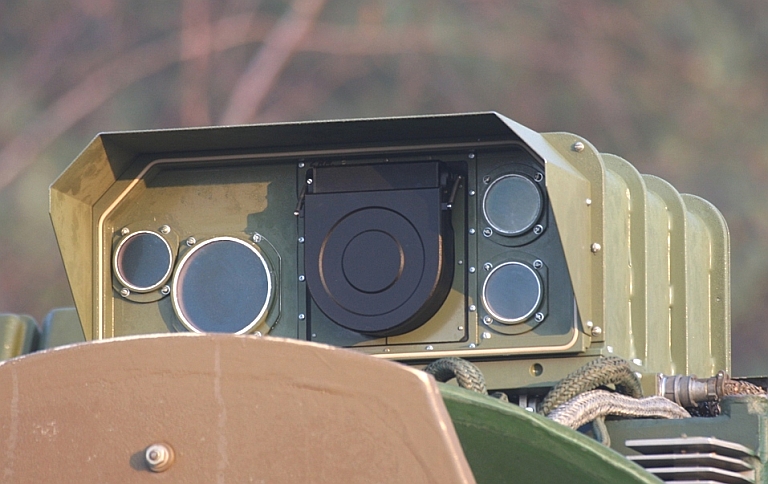
Osa 1T electro-optical targeting system (image © Miroslav Gyűrösi).
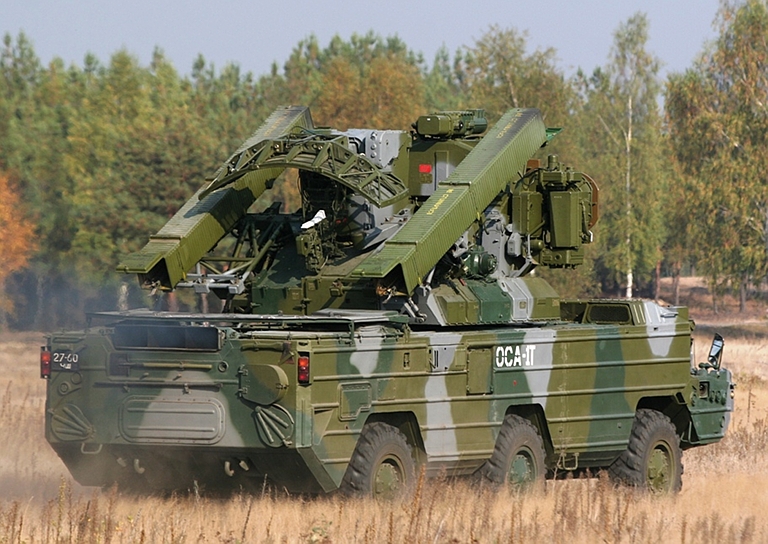
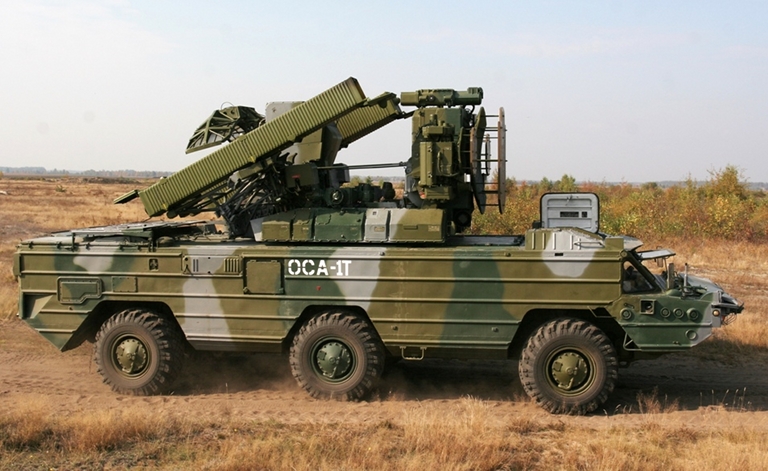
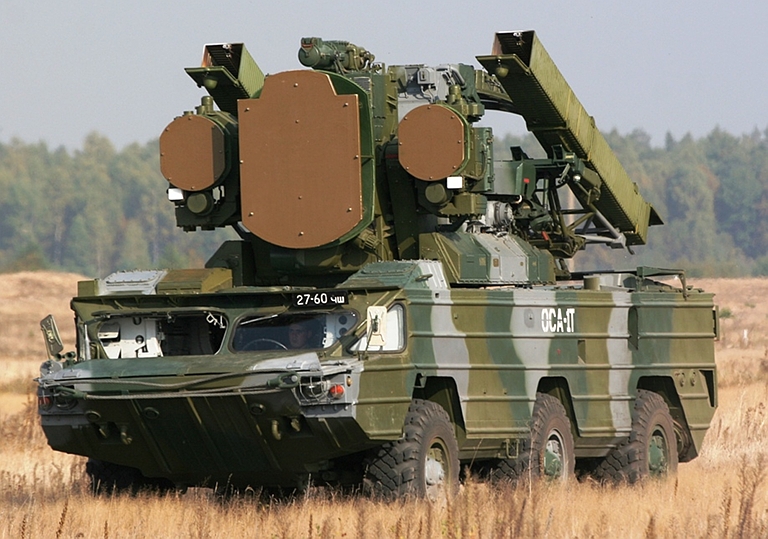
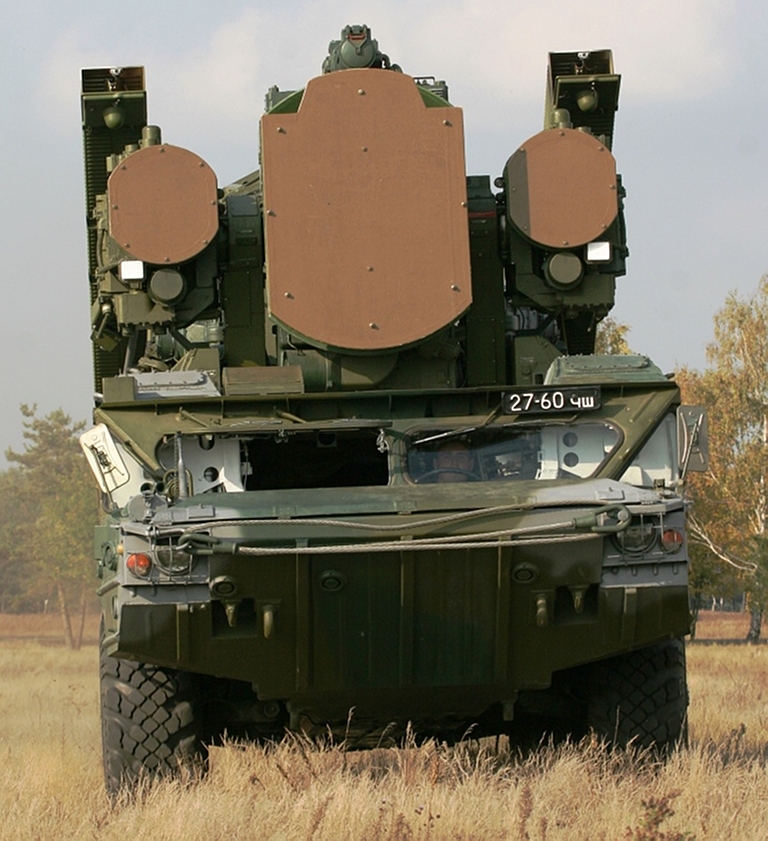
Comparative Characteristics of ADMS (Tetraedr data)
| Characteristics | "ОSA-АКМ" ADMS | "OSA-1T" ADMS |
| 1. Time out of action (deployment), min | 4 | 4 |
| 2. Number of target channels | 1 | 1(2) |
| 3. Number of missile channels | 2 | 2 |
| 4. Maximum speed of approaching / receding targets, m/sec | 500 / 300 | 700 / 350 |
| 5. Minimal altitude of target engaged, km | 0.025 | 0.025 |
| 6. Maximum altitude of target engaged, km | 5 | 7 |
| 7. Range to remote boundary of
engagement
zone (tactical fighter / helicopter), km: |
10.3 / 6.5 | 12 / 10 |
| 8. Maximum course parameter of the target engaged, km | 6 | 8 |
| 9. Guidance methods | Тhree points, Н, Fi, High trajectory | KDC, MТP |
| 10. Kill probability with one missile: a) tactical fighter b) helicopter c) maneuvering target |
0.5 - 0.7 0.4 - 0.7 0.2 - 0.5 |
0.6 - 0.8 0.6 - 0.8 0.4 - 0.7 |
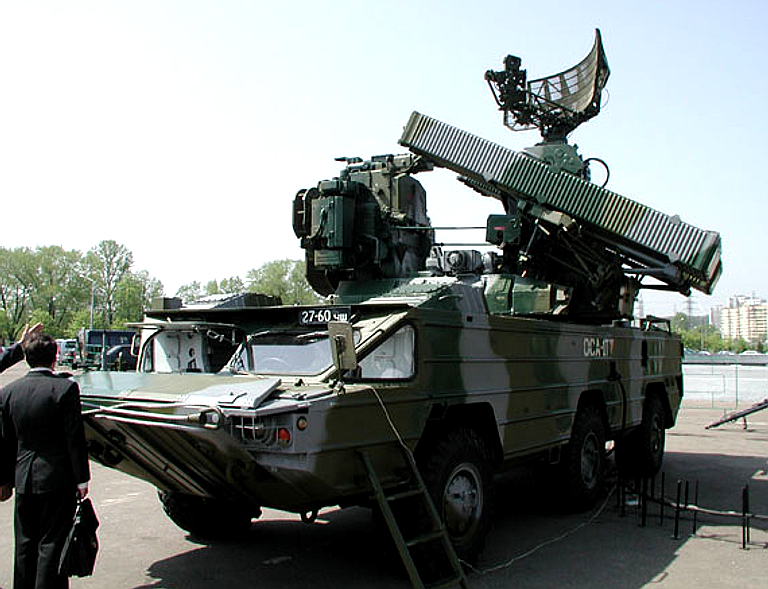
Tetraedr Osa 1T legacy TELAR (Tetraedr image).
9K35M4 Strela 10M4 / 9K35A Gyurza / SA-13 Gopher Upgrades
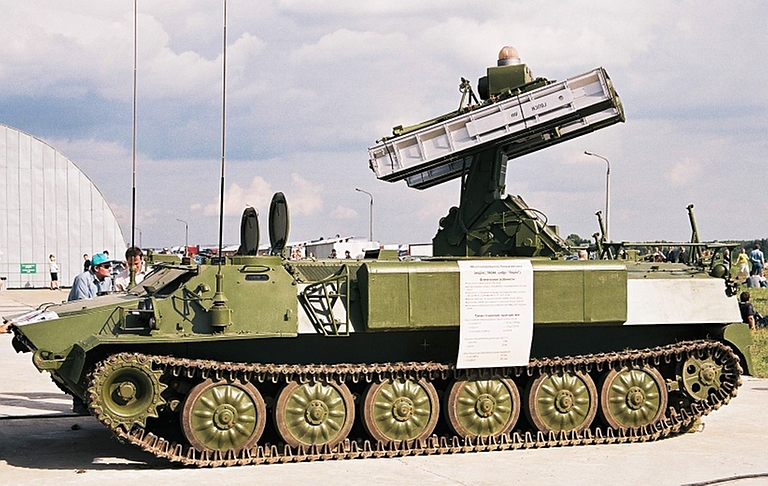
9K35M4 Strela 10M4 TELAR Upgrade
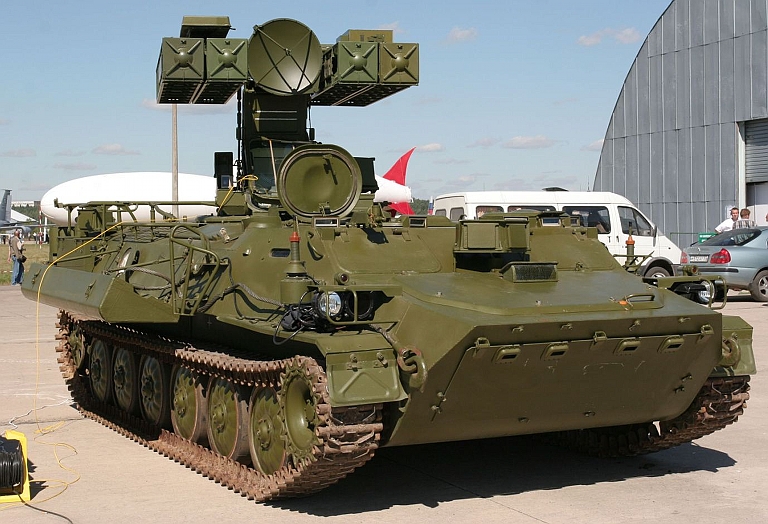
The Strela-10 short-range ADMS is designed to provide close air cover for ground forces in all types of combat operations and on the march, as well as to protect installations against low-altitude airborne threats, including fixed- and rotary-wing aircraft, cruise missiles, remotely piloted vehicles, under conditions of natural clutter and man-made optical (thermal) interferences by day and night, in restricted visibility conditions.
There are two modernisation options of the Strela-10 mobile short-range self-contained ADMS, namely: [KBtochmash] Strela-10M4 and Strela-10A (9A35A Gyurza). The upgraded systems can launch missiles from stationary positions, at short halts and on the move, both against approaching and receding targets.
For its deployment in restricted visibility/night conditions, the system is fitted with a new night sight with thermal imager and/or LLLTV camera.
Composition
- combat assets, including: 9A35M2(M3), 9A35M2(M3) or 9A35M(9A35M) combat vehicle upgraded to ensure automatic target designation data reception
- 9M37M1, 9M37MD, and 9M333 SAMs (four missiles per each TEL)
- night sight
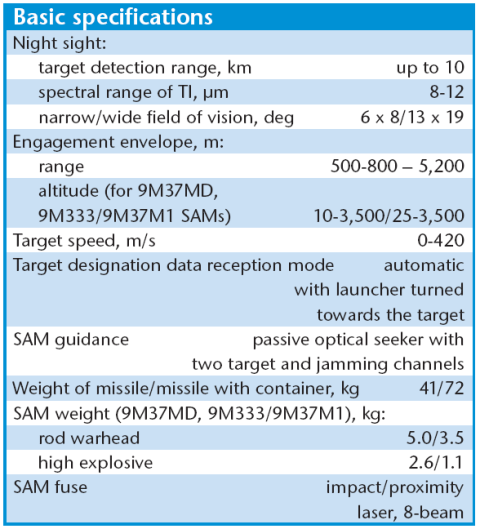
Rosoboronexport table.
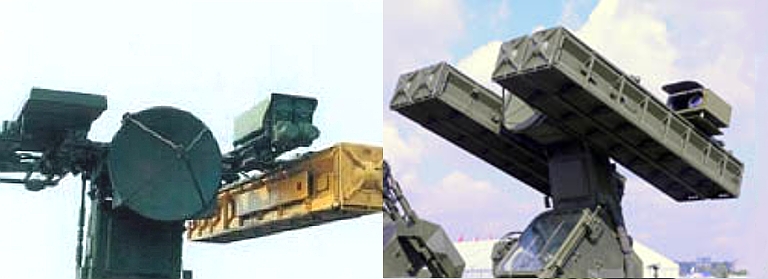
Strela 10M4 upgrade electro-optical tracking system with FLIR and LLLTV imagers, mounted above missile launch tube/container (Rosoboronexport).
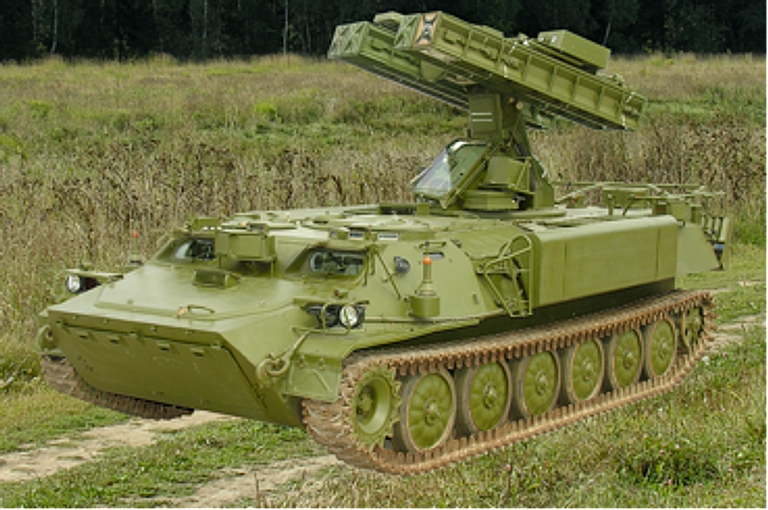
9K35A Gyurza 9A34M3/9A35M3 TELAR Upgrade
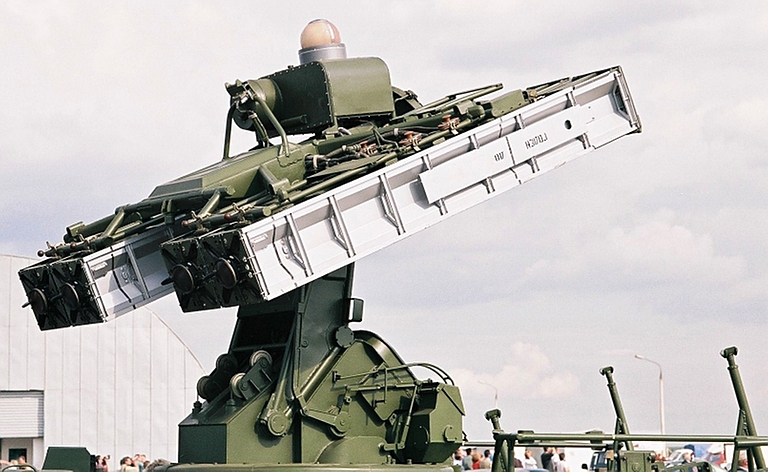
Rosoboronexport Description (Cite):
Modernised Gyurza is distinguished from the basic system by the combat vehicle outfitted with all-round Azov L-136 MAK-F IR detection/acquisition system with digital computer, control and display panel. The Gyurza ADMS is operational round-the-clock, including nighttime.
The modernised Strela-10M Gyurza system features:
- automatic detection of aerial targets by day and night, beyond visual range;
- automatic selection of the most dangerous targets for engagement;
- fully automated pre-launch combat procedures;
- indication of tracked target paths and air target bearings;
- automated control of the launcher's actuators to guide SAM homing head on target;
- remote combat management of the battery combat vehicles from one of the TELARs assigned as a commander's vehicle, or from a remote control panel at a distance of up to 300 m;
- display of technical status and operability of the TEL onboard systems;
- centralised operation when remotely controlled from the command post.
| Cтанция
обнаружения воздушных целей Л-136 L-136 MAK-F IRST |
||
| Зона
обнаружения
по
дальности
(цель типа F-15), км Detection range versus F-15 type target [km] |
10..15 | |
| Зона
обнаружения
по
углу
места, град Elevation coverage [deg] |
0..30 | |
| Зона
обнаружения
по
азимуту,
град Azimuthal coverage [deg] |
360 | |
| Время
обзора,
с Search duration [sec] |
1.1 | |
| Ошибки
измерения,
мин Tracking error [min] |
15..20 | |
| Вес,
кг Mass [kg] |
50 | |
| Потребляемая
мощность,
кВт Power consumption [kW] |
1.3 | |
| Боевая машина TELAR |
||
| Максимальная
скорость
движения
по
шоссе, км/ч Max road speed [km/h] |
60 | |
| Максимальная
скорость
движения
по
воде, км/ч Max speed in water [km/h] |
6 | |
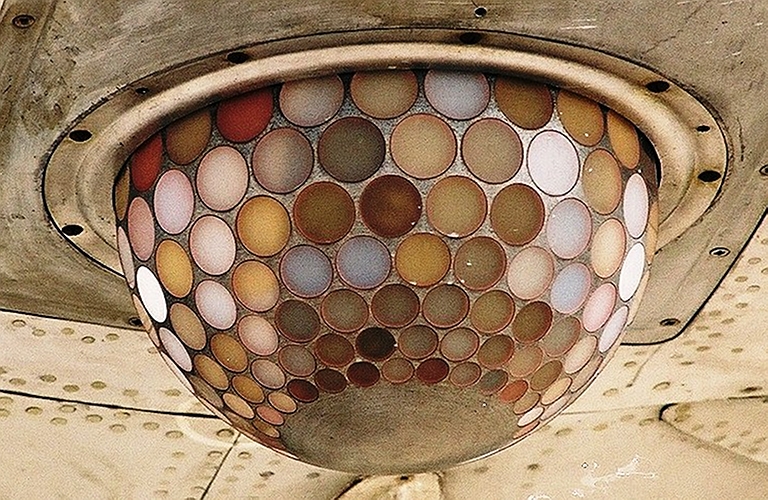
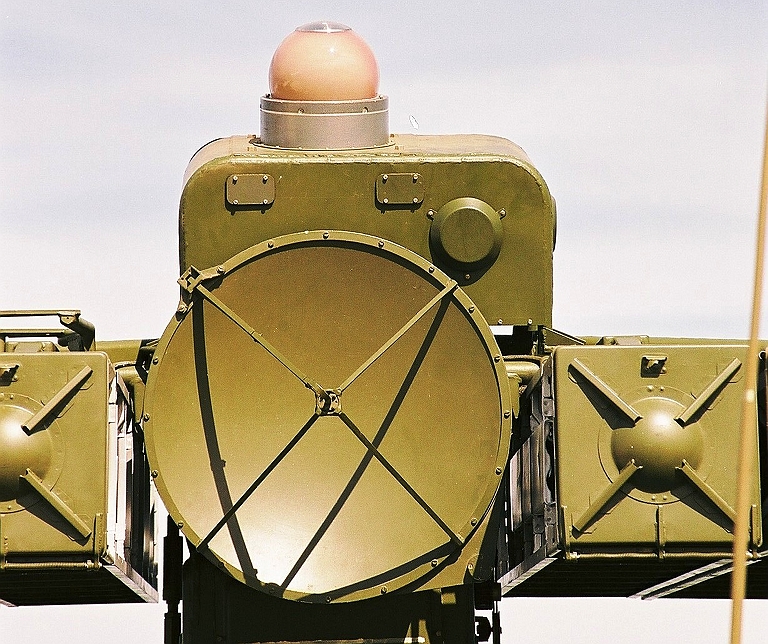
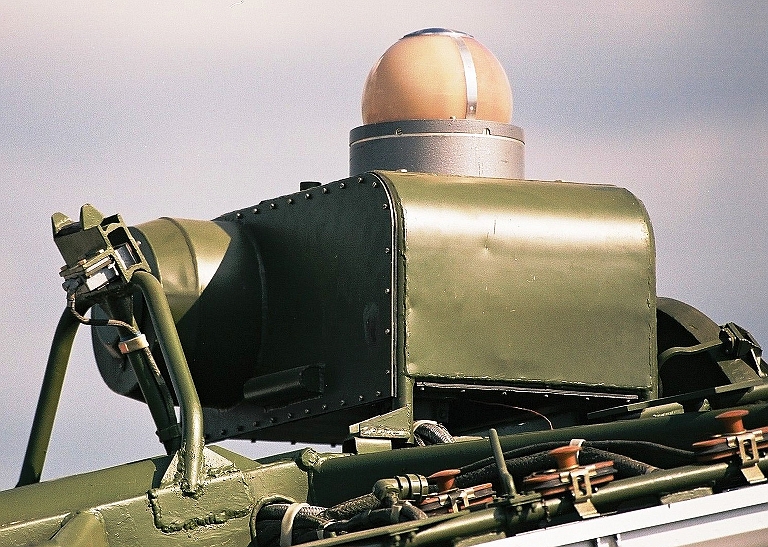
Detail of L-136 sensor head and electronics enclosure.
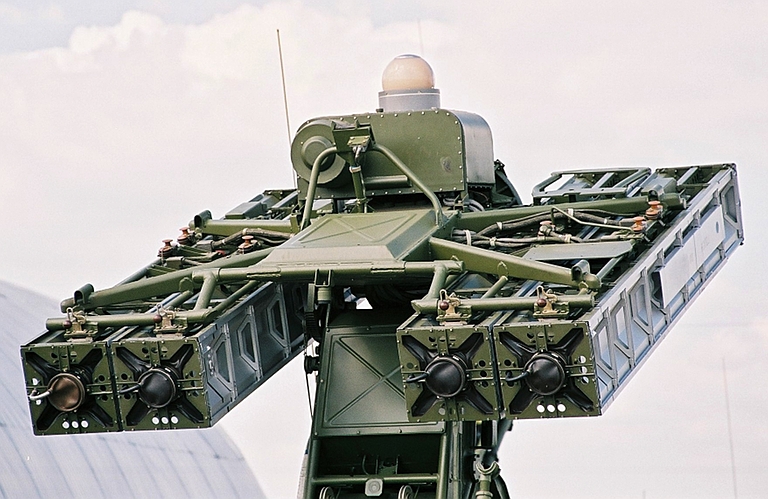
Above, below, detail of L-136 installation and mounting.
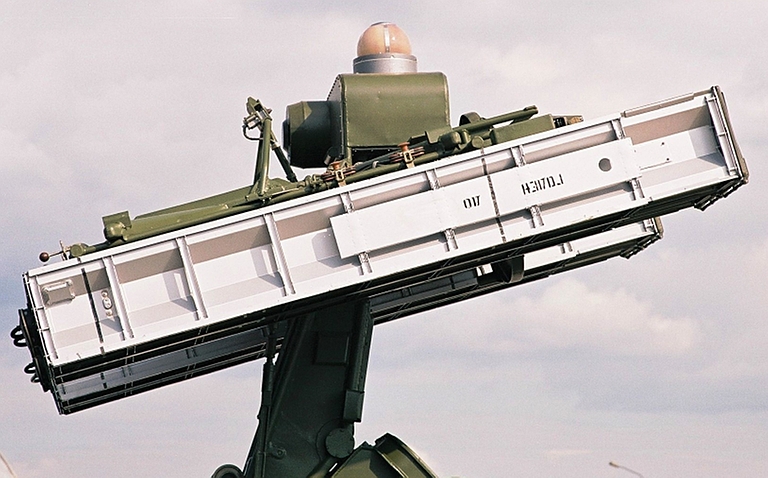
ZSU-23-4M4 Shilka SPAAGM
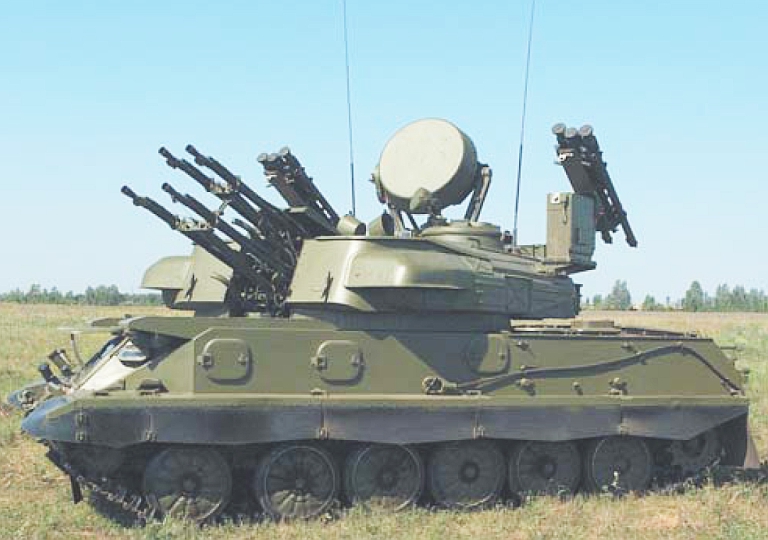
Profound modernisation of the vintage ZSU-23-4 Shilka systems is proposed as ZSU23-4M4. Hit probability (with up to 300 rounds allowance) of the upgraded Shilka against one air target passing through its engagement envelope is increased by 0.6 approaching that of a close-range ADMS.
ZSU-23-4 Shilka SPAAG system modernisation envisages:
- replacement of the existing with advanced radar system featuring improved performance;
- replacement of the analogue with up-todate digital computer;
- introduction of equipment to receive external target designation data, ensuring automated combat control of the AA gun from a command post of the unit;
- introduction of built-in test equipment, as well as a multi-functional simulator to provide training at operators’ workstations;
- introduction of self-defence system elements: to protect the SPAAG system against high-precision weapons, to reduce its IR signature, as well as fitting it with an air conditioning system.
The Shilka modernisation programme is aimed at improving control, operational and life support capabilities. It includes upgrading of tracked chassis and primary power supply system. An economical diesel-electric power unit improves combat control and crew’s working conditions.
At customer request, the SPAAG system can mount a set of control equipment with two Strelets-23 launch modules, designed to carry and launch four Igla-type missiles, as well as an IFF transponder complying with customer's existing standards.
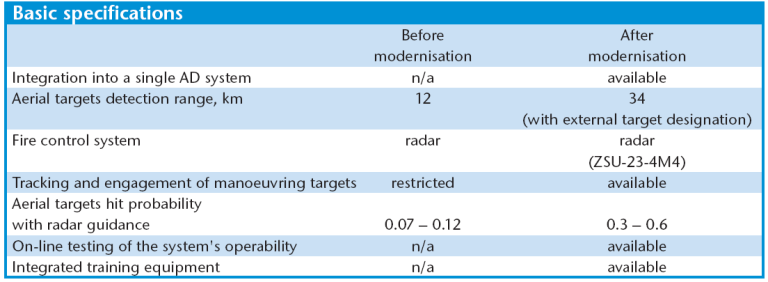
Annexes and Supplements
Annex A Defence Systems S-125-2M Pechora 2M [IMINT]
Technical Report APA-TR-2009-0601
|
|||||||||||||
![Sukhoi PAK-FA and Flanker Index Page [Click for more ...]](APA/flanker.png) |
![F-35 Joint Strike Fighter Index Page [Click for more ...]](APA/jsf.png) |
![Weapons Technology Index Page [Click for more ...]](APA/weps.png) |
![News and Media Related Material Index Page [Click for more ...]](APA/media.png) |
||||||||||
![Surface to Air Missile Systems / Integrated Air Defence Systems Index Page [Click for more ...]](APA/sams-iads.png) |
![Ballistic Missiles and Missile Defence Page [Click for more ...]](APA/msls-bmd.png) |
![Air Power and National Military Strategy Index Page [Click for more ...]](APA/strategy.png) |
![Military Aviation Historical Topics Index Page [Click for more ...]](APA/history.png)
|
![Information Warfare / Operations and Electronic Warfare Index Page [Click for more ...]](APA/iw.png) |
![Systems and Basic Technology Index Page [Click for more ...]](APA/technology.png) |
![Related Links Index Page [Click for more ...]](APA/links.png) |
|||||||
![Homepage of Australia's First Online Journal Covering Air Power Issues (ISSN 1832-2433) [Click for more ...]](APA/apa-analyses.png) |
|||||||||||||
| Artwork, graphic design, layout and text © 2004 - 2014 Carlo Kopp; Text © 2004 - 2014 Peter Goon; All rights reserved. Recommended browsers. Contact webmaster. Site navigation hints. Current hot topics. | |||||||||||||
|
Site Update
Status:
$Revision: 1.753 $
Site History: Notices
and
Updates / NLA Pandora Archive
|
|||||||||||||
|
|
Tweet | Follow @APA_Updates | |||||||||||
|
|
|||||||||||||
|
|
|||||||||||||
![F-111 Aardvark Index Page [Click for more ...]](APA/f-111.png)
![F/A-18 Hornet and Super Hornet Index Page [Click for more ...]](APA/fa-18a.png)
![Aerial Refuelling and Airlift Capabilities Index Page [Click for more ...]](APA/aar-lift.png)
![Directed Energy Weapons and Electromagnetic Bombs Index Page [Click for more ...]](APA/dew.png)
![Notices and Updates Index Page [Click for more ...]](APA/notices-128.png)
![APA NOTAM and Media Release Index Page [Click for more ...]](APA/notams-128.png)
![APA Research Activities and Policy / Technical Reports Index [Click for more ...]](APA/research-128.png)
![Search Air Power Australia Website [Click for more ...]](APA/search-128.png)
![Briefings and Submissions - Air Power Australia [Click for more ...]](APA/briefs-128.png)
![Air Power Australia Contacts [Click for more ...]](APA/contacts-128.png)
![Funding Air Power Australia [Click for more ...]](APA/funding-258.png)
